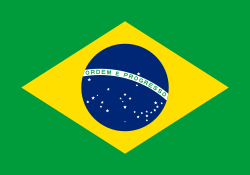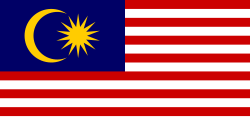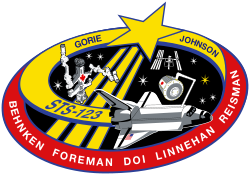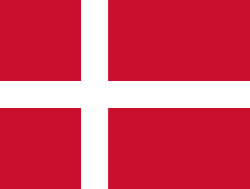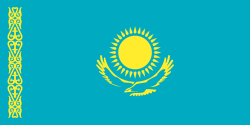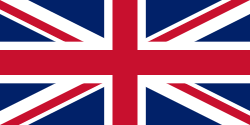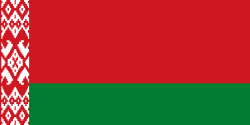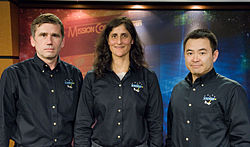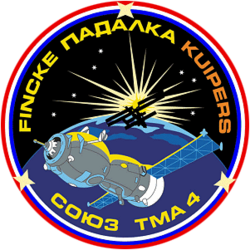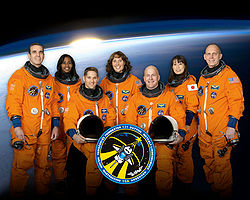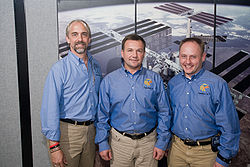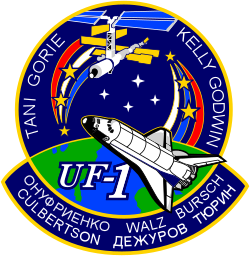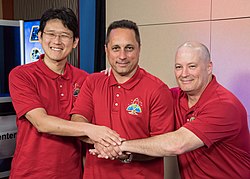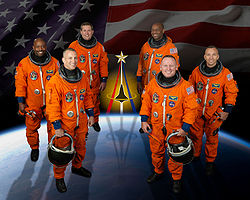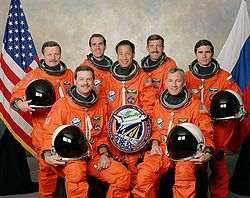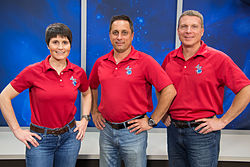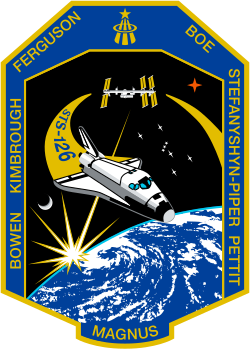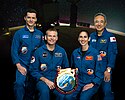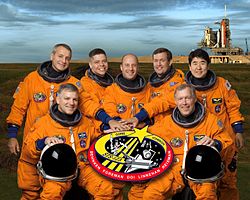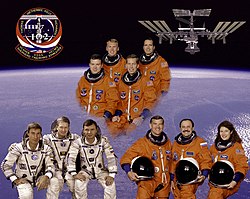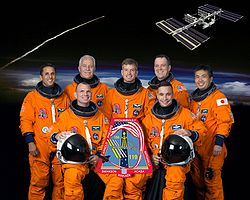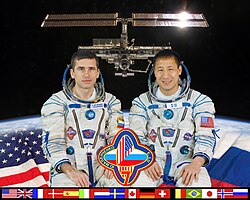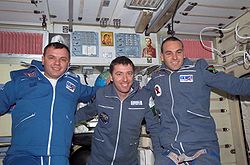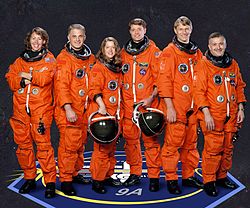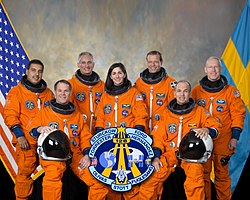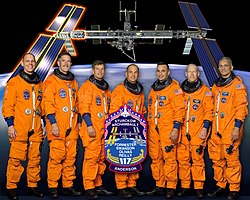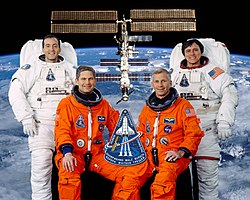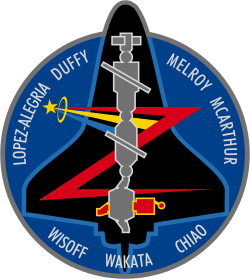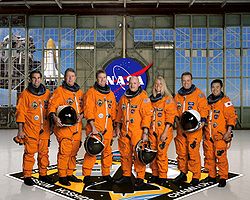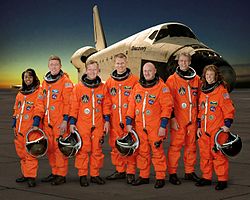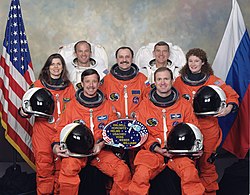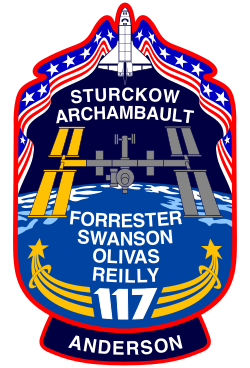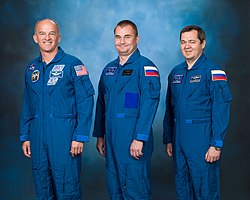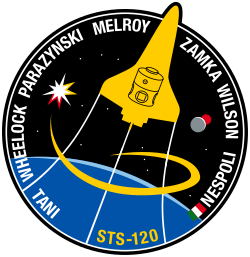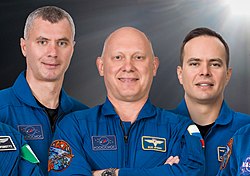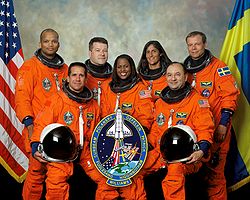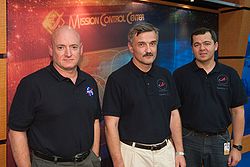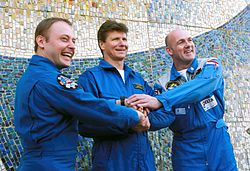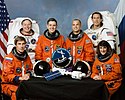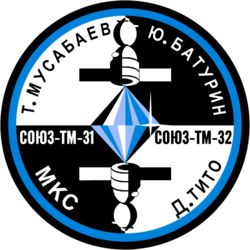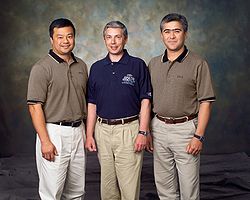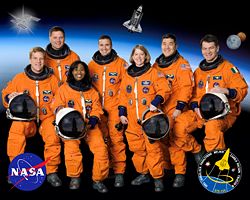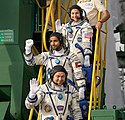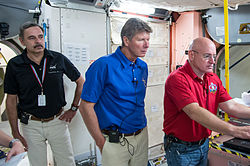Seznam pilotovaných letů k ISS
Toto je chronologický seznam pilotovaných letů k Mezinárodní vesmírné stanici (ISS). Nepilotované lety jsou uvedeny v seznamu nepilotovaných letů k Mezinárodní vesmírné stanici. Členové základních posádek ISS jsou v seznamu uvedeni tučně. "Doba připojení" se týká doby spojení kosmických lodí s vesmírnou stanicí, nemusí vždy odpovídat době pobytu některých členů posádek.
Pilotované lety k ISS
| Mise | Posádka | Foto posádky | Znak mise | Poznámky | |
|---|---|---|---|---|---|
| 1. | STS-88 Endeavour Start: 4. prosince 1998 Doba připojení: 6 dní 18h |
|  | 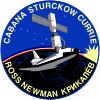 | Připojení modulu Unity 3 kosmické výstupy |
| 2. | STS-96 Discovery Start: 27. května 1999 Doba připojení: 5 dní 18h |
| 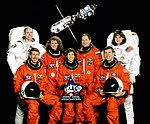 |  | 1 kosmický výstup |
| 3. | STS-101 Atlantis Start: 19. května 2000 Doba připojení: 5 dní 18h |
|  |  | Zvýšení oběžné dráhy o ~30 km 1 kosmický výstup |
| 4. | STS-106 Atlantis Start: 8. září 2000 Doba připojení: 7 dní 21h |
|  |  | 1 kosmický výstup |
| 5. | STS-92 Discovery Start: 11. října 2000 Doba připojení: 6 dní 21h |
|  |  | Připojení příhradové konstrukce Z1 4 kosmické výstupy |
| 6. | Sojuz TM-31 Start: 31. října 2000 Doba připojení: ~183 dní |  |  | Přílet posádky Expedice 1 | |
| 7. | STS-97 Endeavour Start: 30. listopadu 2000 Doba připojení: 6 dní 23h |
|  |  | Připojení příhradové konstrukce P6 (solární panel) 3 kosmické výstupy |
| 8. | STS-98 Atlantis Start: 7. února 2001 Doba připojení: 6 dní 21h |
|  |  | Připojení laboratoře Destiny 3 kosmické výstupy |
| 9. | STS-102 Discovery Start: 8. března 2001 Doba připojení: 8 dní 21h |
|  |  | Použití transportního modulu MPLM přílet posádky Expedice 2 |
| 10. | STS-100 Endeavour Start: 19. dubna 2001 Doba připojení: 8 dní 3h |
| 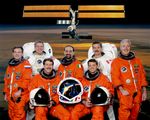 |  | Použití transportního modulu MPLM instalace staničního manipulátoru Canadarm2 |
| 11. | Sojuz TM-32 Start: 28. dubna 2001 Doba připojení: ~183 dní |
|  |  | Celá tříčlenná posádka se po týdnu vrátila Sojuzem TM-31 |
| 12. | STS-104 Atlantis Start: 12. července 2001 Doba připojení: 8 dní 1h |
| 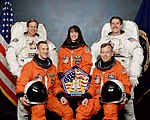 |  | Instalace přechodové komory Quest 3 kosmické výstupy |
| 13. | STS-105 Discovery Start: 10. srpna 2001 Doba připojení: 9 dní 20h |
|  |  | Připojení ruského modulu Pirs použití transportního modulu MPLM |
| 14. | Sojuz TM-33 Start: 21. října 2001 Doba připojení: ~193 dní |
|  |  | Celá tříčlenná posádka se po 9 dnech a 18 hodinách vrátila Sojuzem TM-32 |
| 15. | STS-108 Endeavour Start: 5. prosince 2001 Doba připojení: 7 dní 21h |
|  |  | Použití transportního modulu MPLM přílet posádky Expedice 4 |
| 16. | STS-110 Atlantis Start: 8. dubna 2002 Doba připojení: 7 dní 2h |
|  |  | Připojení příhradové konstrukce S0 4 kosmické výstupy |
| 17. | Sojuz TM-34 Start: 25. dubna 2002 Doba připojení: ~196 dní |
|  |  | Celá tříčlenná posádka se po 8 dnech vrátila Sojuzem TM-33 |
| 18. | STS-111 Endeavour Start: 5. června 2002 Doba připojení: 7 dní 22h |
|  | 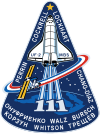 | Použití transportního modulu MPLM připojení mobilního systému pro Canadarm2 |
| 19. | STS-112 Atlantis Start: 7. října 2002 Doba připojení: 6 dní 21h |
|  |  | Připojení příhradové konstrukce S1 3 kosmické výstupy |
| 20. | Sojuz TMA-1 Start: 30. října 30 2002 Doba připojení: ~183 dní |  | 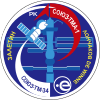 | Celá tříčlenná posádka se po týdnu vrátila Sojuzem TM-34 | |
| 21. | STS-113 Endeavour Start: 24. listopadu 2002 Doba připojení: 6 dní 22h |
| 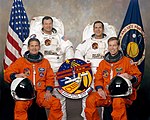 |  | Připojení příhradové konstrukce P1 přílet posádky Expedice 6 |
| Poznámka: Po havárii raketoplánu Columbia 1. února 2003 byly lety raketoplánů pozastaveny až do července 2005. Stavba ISS byla přerušena do září 2006 (mise STS-115). | |||||
| 22. | Sojuz TMA-2 Start: 28. dubna 2003 Doba připojení: ~182 dní |  | Přílet posádky Expedice 7 posádka Expedice 6 se vrátila po několika dnech v Sojuzu TMA-1 | ||
| 23. | Sojuz TMA-3 Start: 18. října 2003 Doba připojení: ~192 dní |  |  | Přílet posádky Expedice 8 Duque se vrátil po několika dnech s posádkou Expedice 7 v Sojuzu TMA-2 | |
| 24. | Sojuz TMA-4 Start: 19. dubna 2004 Doba připojení: ~185 dní |  | 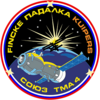 | Přílet posádky Expedice 9 Kuipers se po devíti dnech vrátil s posádkou Expedice 8 v Sojuzu TMA-3 | |
| 25. | Sojuz TMA-5 Start: 14. října 2004 Doba připojení: ~190 dní | 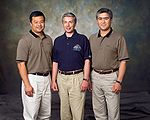 |  | Přílet posádky Expedice 10 Šargin se po několika dnech vrátil s posádkou Expedice 9 v Sojuzu TMA-4 | |
| 26. | Sojuz TMA-6 Start: 15. dubna 2005 Doba připojení: ~179 dní | Přílet posádky Expedice 11 Vittori se po několika dnech vrátil s posádkou Expedice 10 v Sojuzu TMA-5 | |||
| 27. | STS-114 Discovery Start: 26. července 2005 Doba připojení: 8 dní 20h |
|  |  | Obnovení letů raketoplánu Použití transportního modulu MPLM |
| 28. | Sojuz TMA-7 Start: 1. října 2005 Doba připojení: ~189 dní |
|  | Přílet posádky Expedice 12 Olsen se vrátil po několika dnech s posádkou Expedice 11 v Sojuzu TMA-6 | |
| 29. | Sojuz TMA-8 Start: 30. března 2006 Doba připojení: ~180 dní |  | Přílet posádky Expedice 13 Pontes se vrátil po 9 dnech s posádkou Expedice 12 v Sojuzu TMA-7 | ||
| 30. | STS-121 Discovery Start: 4. července 2006 Doba připojení: ~9 dní |
|  |  | Přílet Reitera do posádky Expedice 13, kontrola raketoplánu z ISS, 3 kosmické výstupy |
| 31. | STS-115 Atlantis Start: 9. září 2006 Doba připojení: ~7 dní |
| 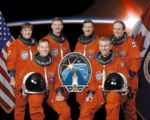 |  | Připojení příhradové konstrukce P3/P4 včetně solárních panelů, kontrola raketoplánu z ISS, 3 kosmické výstupy |
| 32. | Sojuz TMA-9 Start: 18. září 2006 Doba připojení: 215 dní |
|  | Přílet posádky Expedice 14 Ansariová se vrátila po 8 dnech s posádkou Expedice 13 v Sojuzu TMA-8 | |
| 33. | STS-116 Discovery Start: 10. prosince 2006 Doba připojení: 7 dní 23h |
| 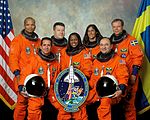 |  | Připojení příhradové konstrukce P5, kontrola raketoplánu z ISS, 4 kosmické výstupy |
| 34. | Sojuz TMA-10 Start: 7. dubna 2007 Doba připojení: ~196 dní |
|  | Přílet posádky Expedice 15 Simonyi se vrátil po 12 dnech s posádkou Expedice 14 v Sojuzu TMA-9 | |
| 35. | STS-117 Atlantis Start: 8. června 2007 Doba připojení: ~10 dní |
|  | 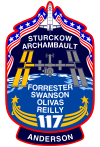 | Přílet Andersona do posádky Expedice 15 připojení příhradové konstrukce S3/S4 včetně solárních panelů, kontrola raketoplánu z ISS, 4 kosmické výstupy |
| 36. | STS-118 Endeavour Start: 8. srpna 2007 Doba připojení: ~10 dní |
| 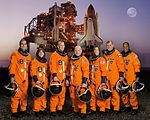 |  | Připojení příhradové konstrukce S5, kontrola raketoplánu z ISS, 4 kosmické výstupy |
| 37. | Sojuz TMA-11 Start: 10. října 2007 Doba připojení: ~189 dní |  | Přílet posádky Expedice 16, biologické experimenty Shukor se vrátil po několika dnech s posádkou Expedice 15 v Sojuzu TMA-10 | ||
| 38. | STS-120 Discovery Start: 23. října 2007 Doba připojení: ~12 dní |
|  |  | Instalace modulu Harmony, přemístění příhradové konstrukce P6, 5 kosmických výstupů |
| 39. | STS-122 Atlantis Start: 7. února 2008 Doba připojení: 12 dní 18 h |
|  | 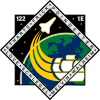 | Instalace evropské laboratoře Columbus |
| 40. | STS-123 Endeavour Start: 11. března 2008 Doba připojení: 16 dní, 8 hodin, 25 minut |
|  |  | Instalace Kibō - experimentálního logistického modulu a dvouramenného robotického telemanipulátoru SPDM |
| 41. | Sojuz TMA-12 Start: 8. dubna 2008 Doba připojení: 196 dní, 11 hodin, 19 minut |  | Přílet posádky Expedice 17 Yi So-yeon se vrátila po několika dnech s posádkou Expedice 16 v Sojuzu TMA-11 | ||
| 42. | STS-124 Start: 31. května 2008 Doba připojení: 8 dní, 17 hodin, 39 minut |
| 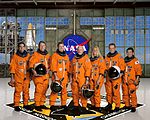 | 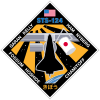 | Výměna člena posádky Expedice 17, montáž přetlakového modulu japonské laboratoře Kibó |
| 43. | Sojuz TMA-13 Start: 12. října 2008 Doba připojení: 175 dní, 19 hodin, 29 minut |
| 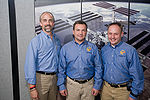 | Přílet posádky Expedice 18 Richard Garriott se vrátil po několika dnech s posádkou Expedice 17 v Sojuzu TMA-12 | |
| 44. | STS-126 Start: 15. listopadu 2008 Doba připojení: 11 dní, 16 hodin, 46 minut |
|  |  | Doplnění zásob a výbavy stanice, údržba a oprava rotačních spojů SARJ (Solar Alpha Rotary Joint), výměna člena posádky Expedice 18 |
| 45. | STS-119 Start: 15. března 2009 Doba připojení: 8 dní, 2 hodiny |
|  | 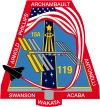 | Montáž nosníku S6 se solárními panely a radiátory, výměna člena posádky Expedice 18 |
| 46. | Sojuz TMA-14 Start: 26. března 2009 Doba připojení: 196 dní, 12 hodin, 2 minuty | 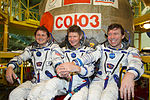 | Přílet posádky Expedice 19 Charles Simonyi se vrátil po několika dnech s posádkou Expedice 18 v Sojuzu TMA-13 | ||
| 47. | Sojuz TMA-15 Start: 27. května 2009 Doba připojení: 185 dní, 18 hodin, 42 minut |  | Přílet poloviny posádky Expedice 20 Zvýšení počtu členů posádky ISS na šest | ||
| 48. | STS-127 Start: 15. července 2009 Doba připojení: 11 dní, 1 hodina |
| 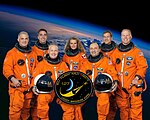 |  | Přivezení a montáž částí japonského modulu Kibó (Exposed Facility a Logistics Module Exposed Section) Výměna člena posádky Expedice 20 |
| 49. | STS-128 Start: 29. srpna 2009 Doba připojení: 9 dní, 19 hodin |
| 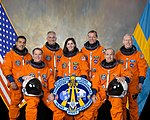 |  | Výměna člena posádky Expedice 20 |
| 50. | Sojuz TMA-16 Start: 30. září 2009 Doba připojení: 166 dní, 23 hodin, 7 minut |  | Přílet poloviny posádky Expedice 21 Guy Laliberté se vrátil po několika dnech s posádkou Expedice 20 v Sojuzu TMA-14 | ||
| 51. | STS-129 Start: 16. listopadu 2009 Doba připojení: 6 dní, 18 hodin, 2 minuty |
|  | 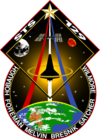 | Doprava zásob a náhradních dílů na stanici, příprava ISS na přílet nového modulu Tranquility (Node 3). Návrat členky Expedice 21 Nicole Stottové na Zemi. |
| 52. | Sojuz TMA-17 Start: 20. prosince 2009 Doba připojení: 163 dní, 1 hodina, 43 minut | 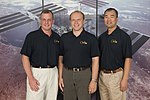 | Přílet tří členů posádky Expedice 22 | ||
| 53. | STS-130 Start: 8. února 2010 Doba připojení: 9 dní, 19 hodin, 48 minut |
| 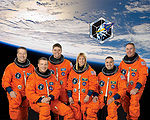 |  | Montáž modulů Tranquility (Node 3) a Cupola. |
| 54. | Sojuz TMA-18 Start: 2. dubna 2010 Doba připojení: 173 dní, 20 hodin, 38 minut |  | Přílet tří členů posádky Expedice 23 | ||
| 55. | STS-131 Start: 5. dubna 2010 Doba připojení: 10 dní, 5 hodin, 8 minut |
| 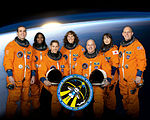 |  | Zásobovací mise, na ISS dopraven logistický MPLM modul Leonardo a nová nádrž ATA s amoniakem pro termoregulační systém stanice. |
| 56. | STS-132 Start: 14. května 2010 Doba připojení: 7 dní, 56 minut |
|  |  | Zásobovací mise, na ISS dopraven a připojen ruský modul MIM-1 Rassvet. |
| 57. | Sojuz TMA-19 Start: 15. června 2010 Doba připojení: 161 dní, 3 hodiny, 2 minuty |  | Přílet tří členů posádky Expedice 24 | ||
| 58. | Sojuz TMA-01M Start: 7. října 2010 Doba připojení: 157 dní, 4 hodiny, 26 minut |  | Přílet tří členů posádky Expedice 25 | ||
| 59. | Sojuz TMA-20 Start: 15. prosince 2010 Doba připojení: 157 dní, 1 hodina, 27 minut |  | Přílet tří členů posádky Expedice 26 | ||
| 60. | STS-133 Start: 24. února 2011 Doba připojení: 8 dní, 14 hodin |
|  | 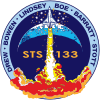 | Na ISS dopravena venkovní logistická plošina ELC, víceúčelový logistický modul Leonardo a robonaut R2 |
| 61. | Sojuz TMA-21 Start: 4. dubna 2011 Doba připojení: ~162 dní |  | Přílet tří členů posádky Expedice 27 | ||
| 62. | STS-134 Start: 16. května 2011 Doba připojení: 11 dní, 17 hodin, 31 minut |
|  |  | Na ISS dopraven spektrometr AMS-2 (Alpha Magnetic Spectrometer) a venkovní logistická plošina ELC-3 |
| 63. | Sojuz TMA-02M Start: 7. června 2011 Doba připojení: ~165 dní |  | Přílet tří členů posádky Expedice 28 | ||
| 64. | STS-135 Start: 8. července 2011 Doba připojení: 8 dní, 15 hodin, 21 minut |  |  | Zásobovací mise, na ISS dopraven víceúčelový logistický modul Raffaello | |
| 65. | Sojuz TMA-22 Start: 14. listopadu 2011 Doba připojení: 163 dní, 2 hodiny, 54 minut | 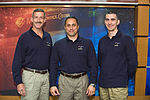 | Přílet tří členů posádky Expedice 29 | ||
| 66. | Sojuz TMA-03M Start: 21. prosince 2011 Doba připojení: 190 dní, 13 hodin, 28 minut |  | Přílet tří členů posádky Expedice 30 | ||
| 67. | Sojuz TMA-04M Start: 15. května 2012 Doba připojení: 122 dní, 18 hodin, 33 minut |  | Přílet tří členů posádky Expedice 31 | ||
| 68. | Sojuz TMA-05M Start: 15. července 2012 Doba připojení: 124 dní, 17 hodin, 35 minut |  | Přílet tří členů posádky Expedice 32 | ||
| 69. | Sojuz TMA-06M Start: 23. října 2012 Doba připojení: 141 dní, 11 hodin, 14 minut |  | Přílet tří členů posádky Expedice 33 | ||
| 70. | Sojuz TMA-07M Start: 19. prosince 2012 Doba připojení: 143 dní, 8 hodin, 59 minut |  | Přílet tří členů posádky Expedice 34 | ||
| 71. | Sojuz TMA-08M Start: 28. března 2013 Doba připojení: 165 dní, 21 hodin, 9 minut | 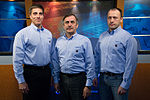 | Přílet tří členů posádky Expedice 35 | ||
| 72. | Sojuz TMA-09M Start: 28. května 2013 Doba připojení: 165 dní, 21 hodin, 15 minut |  | Přílet tří členů posádky Expedice 36 | ||
| 73. | Sojuz TMA-10M Start: 25. září 2013 Doba připojení: 165 dní, 21 hodin, 17 minut |  | Přílet tří členů posádky Expedice 37 | ||
| 74. | Sojuz TMA-11M Start: 7. listopadu 2013 Doba připojení: 187 dní, 12 hodin, 9 minut |  | Přílet tří členů posádky Expedice 38 | ||
| 75. | Sojuz TMA-12M Start: 26. března 2014 Doba připojení: 166 dní, 23 hodin, 8 minut |  | Přílet tří členů posádky Expedice 39 | ||
| 76. | Sojuz TMA-13M Start: 28. května 2014 Doba připojení: 164 dní, 22 hodin, 47 minut |  | Přílet tří členů posádky Expedice 40 | ||
| 77. | Sojuz TMA-14M Start: 25. září 2014 Doba připojení: 166 dní, 20 hodin, 33 minut |  | Přílet tří členů posádky Expedice 41 | ||
| 78. | Sojuz TMA-15M Start: 23. listopadu 2014 Doba připojení: 199 dní, 7 hodin, 31 minut |  | Přílet tří členů posádky Expedice 42 | ||
| 79. | Sojuz TMA-16M Start: 27. března 2015 Doba připojení: 167 dní, 19 hodin, 56 minut |  | Přílet tří členů posádky Expedice 43 | ||
| 80. | Sojuz TMA-17M Start: 22. července 2015 Doba připojení: 141 dní, 7 hodin, 2 minuty |  | Přílet tří členů posádky Expedice 44 | ||
| 81. | Sojuz TMA-18M Start: 2. září 2015 Doba připojení: 179 dní, 17 hodin, 20 minut |  | Přílet jednoho člena posádky Expedice 45 – Volkova; Mogensen a Aimbetov se po několika dnech vrátili s Gennadijem Padalkou v Sojuzu TMA-16 | ||
| 82. | Sojuz TMA-19M Start: 15. prosince 2015 Doba připojení: ~185 dní |  | Přílet tří členů posádky Expedice 46 | ||
| 83. | Sojuz TMA-20M Start: 18. března 2016 Doba připojení: 171 dní, 18 hodin, 41 minut |  | Přílet tří členů posádky Expedice 47 | ||
| 84. | Sojuz MS-01 Start: 7. července 2016 Doba připojení: ~113 dní |  | Přílet tří členů posádky Expedice 48 | ||
| 85. | Sojuz MS-02 Start: 19. října 2016 Doba připojení: ~171 dní |  | Přílet tří členů posádky Expedice 49 | ||
| 86. | Sojuz MS-03 Start: 17. listopadu 2016 Doba připojení: ~194 dní |  | Přílet tří členů posádky Expedice 50 | ||
| 87. | Sojuz MS-04 Start: 20. dubna 2017 Doba připojení: ~135 dní |  | Přílet dvou členů posádky Expedice 51 | ||
| 88 | Sojuz MS-05 Start: 28. července 2017 Doba připojení: 139 dní, 4 hodiny, 57 minut |  | Přílet tří členů posádky Expedice 52 | ||
| 89 | Sojuz MS-06 Start: 12. září 2017 Doba připojení: 167 dní, 20 hodin, 13 minut |  | Přílet tří členů posádky Expedice 53 | ||
| 90 | Sojuz MS-07 Start: 17. prosince 2017 Doba připojení: 166 dní, 0 hodin, 37 minut |  | Přílet tří členů posádky Expedice 54 | ||
| 91 | Sojuz MS-08 Start: 21. března 2018 Doba připojení: 194 dní, 11 hodin, 17 minut |  | Přílet tří členů posádky Expedice 55 | ||
| 92 | Sojuz MS-09 Start: 6. června 2018 Doba připojení: 194 dní, 12 hodin, 41 minut |  | Přílet tří členů posádky Expedice 56 | ||
| 93 | Sojuz MS-10 Neúspěšný start: 11. října 2018 |  | Plánován přílet dvou členů posádky Expedice 57. Během startu nosná raketa havarovala, kosmická loď s kosmonauty nouzově přistála. | ||
| 94 | Sojuz MS-11 Start: 3. prosince 2018 Doba připojení: 203 dní, 15 hodin, 17 minut |  | Přílet tří členů posádky Expedice 58 | ||
| 95 | Sojuz MS-12 Start: 14. března 2019 Doba připojení: 202 dní, 6 hodin, 36 minut |  | Přílet tří členů posádky Expedice 59 | ||
| 96 | Sojuz MS-13 Start: 20. července 2019 Doba připojení: 200 dní, 6 hodin, 39 minut |  | Přílet tří členů posádky Expedice 60 | ||
| 97 | Sojuz MS-15 Start: 25. září 2019 Doba připojení: 204 dní, 6 hodin, 11 minut |
|  | Přílet dvou členů posádky Expedice 61 a člena 19. návštěvní expedice al-Mansúrí. Hazzá al-Mansúrí se po několika dnech pobytu na ISS vrátil na Zemi v Sojuzu MS-12 s Alexejem Ovčininem a Nickem Haguem. | |
| 98 | Sojuz MS-16 Start: 9. dubna 2020 Doba připojení: 195 dní, 9 hodin, 19 minut |  | Přílet tří členů Expedice 62 | ||
| 99 | SpX-DM2 Start: 30. května 2020 Doba připojení: 63 dní, 9 hodin, 8 minut |  |  | Přílet dvou členů Expedice 63, první pilotovaný let americké lodi od ukončení provozu raketoplánů | |
| 100 | Sojuz MS-17 Start: 14. října 2020 Doba připojení: 213 dní, 23 hodin, 10 minut |  | Přílet tří členů Expedice 63. | ||
| 101 | SpaceX Crew-1 Start: 16. listopadu 2020 Doba připojení: 167 dní, 6 hodin, 29 minut |  |  | Přílet čtyř členů Expedice 64. | |
| 102 | Sojuz MS-18 Start: 9. dubna 2021 Doba připojení: 190 dní, 13 hodin, 26 minut |  | Přílet tří členů Expedice 65. Dubrov a Vande Hei pokračovali i v Expedici 66 a na Zemi se vrátili v lodi Sojuz MS-19. | ||
| 103 | SpaceX Crew-2 Start: 23. dubna 2021 Doba připojení: 199 dní, 9 hodin, 7 minut |  |  | Přílet čtyř členů Expedice 65. | |
| 104 | Sojuz MS-19 Start: 5. října 2021 Doba připojení: 175 dní, 18 hodin, 59 minut |  | Přílet jednoho člena Expedice 66 a dvou návštěvníků na krátkodobé misi (Šipenko a Peresildová se vrátili na Zemi v lodi Sojuz MS-18). | ||
| 105 | SpaceX Crew-3 Start: 11. listopadu 2021 Doba připojení: 174 dní, 5 hodin, 48 minut |  |  | Přílet čtyř členů Expedice 66. | |
| 106 | Sojuz MS-20 Start: 8. prosince 2021 Doba připojení: 11 dní, 10 hodin, 9 minut |  | Přílet tří členů 20. návštěvní expedice. | ||
| 107 | Sojuz MS-21 Start: 18. březen 2022 Doba připojení: 194 dní, 19 hodin, 2 minuty |  | Přílet tří členů ruské části Expedice 67. | ||
| 108 | Axiom Mission 1 Start: 8. dubna 2022 Doba připojení: 17 dní, 1 hodina, 49 minut |  | Přílet první soukromé mise z programu společnosti Axiom Space | ||
| 109 | SpaceX Crew-4 Start: 27. dubna 2022 Doba připojení: 169 dní, 16 hodin, 28 minut | 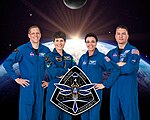 |  | Přílet čtyř členů Expedice 67. | |
| 110 | Sojuz MS-22 Start: 21. září 2022 Doba připojení: 187 dní, 16 hodin, 51 minut |  | Přílet tří členů Expedice 68. V důsledku poškození chladicího systému lodi během připojení k ISS loď od stanice odletěla v automatickém režimu a návratová kabina přistála bez posádky. | ||
| 111 | SpaceX Crew-5 Start: 5. října 2022 Doba připojení: 155 dní, 10 hodin, 19 minut |  |  | Přílet čtyř členů Expedice 68. | |
| 112 | Sojuz MS-23 Start: 24. února 2023 Doba připojení: 213 dní, 6 hodin, 20 minut |  | Loď se po startu bez posádky v automatickém režimu připojila k ISS jako náhradní kosmická loď, v níž se na Zemi vrátila posádka dopravená na stanice předchozí lodi Sojuz MS-22. Prokopjev, Petělin a Rubio tak pokračovali na ISS i během Expedice 69. | ||
| 113 | SpaceX Crew-6 Start: 2. března 2023 Doba připojení: 184 dní, 4 hodiny, 25 minut[p. 1] |  |  | Přílet čtyř členů Expedice 69. | |
| 114 | Axiom Mission 2 Start: 21. května 2023 Doba připojení: 8 dní, 1 hodina, 53 minut |  | Druhá soukromá mise programu Axiom Space | ||
| 115 | SpaceX Crew-7 Start: 26. srpna 2023 Doba připojení: 197 dní, 2 hodiny, 4 minuty |  |  | Přílet čtyř členů Expedice 70. | |
| 116 | Sojuz MS-24 Start: 15. září 2023 Doba připojení: 203 dní, 9 hodin, 0 minut |  | Přílet zbylých tří členů Expedice 70. Na místech Kononěnka a Čuba se na Zemi ze své krátkodobé 21. návštěvní expedice na ISS vrátili Oleg Novickij a Maryna Vasileuská. | ||
| 117 | Axiom Mission 3 Start: 18. ledna 2024 Doba připojení: 18 dní, 3 hodiny, 38 minut |
|  | Třetí soukromá mise programu Axiom Space | |
| 118 | SpaceX Crew-8 Start: 4. března 2024 Doba připojení: 232 dní, 13 hodin, 37 minut[p. 2] |  |  | Přílet čtyř členů Expedice 71. | |
| 119 | Sojuz MS-25 Start: 23. března 2024 Doba připojení: 181 dní, 17 hodin, 33 minut |  | Přílet poslední členky Expedice 71 a dvoučlenné 21. návštěvní posádky. Návštěvníci Novickij a Vasileuská přistáli dva týdny po startu v kosmické lodi Sojuz MS-24. S Caldwellovou Dysonovou na konci Expedice 71 (a svého ročního pobytu na ISS) na Zemi odletěli Oleg Kononěnko a Nikolaj Čub. | ||
| 120 | Boeing CFT Start: 5. června 2024 Doba připojení: 92 dní, 4 hodiny, 30 minut |  | Přílet dvoučlenné posádky na první pilotované testovací misi nové kosmické lodi Starliner. Cestu zpět na Zemi loď z bezpečnostních důvodů absolvovala bez posádky, která se připojí k následující misi SpaceX Crew-9. | ||
| 121 | Sojuz MS-26 Start: 11. září 2024 Doba připojení: let pokračuje |  | Přílet první části Expedice 72. | ||
| 122 | SpaceX Crew-9 Start: 28. září 2024 Doba připojení: let pokračuje |  |  | Přílet dvou členů Expedice 72. Jejími dalšími členy se stali také Barry Wilmore a Sunita Williamsová, kteří na stanici přiletěli v misi Boeing CFT. Ti se zařadili také do posádky Crew-9 a v lodi se v na jaře 2025 vrátí na Zemi. | |
(Zeleně jsou vyznačeny pokračující mise.)
Odkazy
Poznámky
Reference
V tomto článku byl použit překlad textu z článku List of manned spaceflights to the ISS na anglické Wikipedii.
- NASA Archivováno 28. 6. 2013 na Wayback Machine.
Externí odkazy
Média použitá na této stránce
Flag of Canada introduced in 1965, using Pantone colors. This design replaced the Canadian Red Ensign design.
Used color: National flag | South African Government and Pantone Color Picker
| zelená | rendered as RGB 0 119 73 | Pantone 3415 C |
| žlutá | rendered as RGB 255 184 28 | Pantone 1235 C |
| červená | rendered as RGB 224 60 49 | Pantone 179 C |
| modrá | rendered as RGB 0 20 137 | Pantone Reflex Blue C |
| bílá | rendered as RGB 255 255 255 | |
| černá | rendered as RGB 0 0 0 |
This is the national flag of Belgium, according to the Official Guide to Belgian Protocol. It has a 13:15 aspect ratio, though it is rarely seen in this ratio.
Its colours are defined as Pantone black, Pantone yellow 115, and Pantone red 032; also given as CMYK 0,0,0,100; 0,8.5,79,0; and 0,94,87,0.STS-123 continues assembly of the International Space Station (ISS). The primary mission objectives include rotating an expedition crew member and installing both the first component of the Japanese Experimental Module (the Experimental Logistics Module - Pressurized Section (ELM-PS)) and the Canadian Special Purpose Dexterous Manipulator (SPDM). In addition, STS-123 will deliver various spare ISS components and leave behind the sensor boom used for inspecting the shuttle's thermal protection system. A follow-on mission to ISS will utilize and then return home with this sensor boom. A total of five spacewalks are planned to accomplish these tasks. The mission will also require the use of both the shuttle and ISS robotic arms. STS-123 will utilize the Station-Shuttle Power Transfer System to extend the docked portion of the mission to eleven days, with a total planned duration of 15 days. The crew patch depicts the space shuttle in orbit with the crew names trailing behind. STS-123's major additions to ISS (the ELM-PS installation with the shuttle robotic arm and the fully constructed SPDM) are both illustrated. The ISS is shown in the configuration that the STS-123 crew will encounter when they arrive.
NASA astronaut Sunita Williams, Expedition 32 flight engineer and Expedition 33 commander; along with Russian cosmonaut Yuri Malenchenko (left) and Japan Aerospace Exploration Agency (JAXA) astronaut Akihiko Hoshide, both Expedition 32/33 flight engineers, pose for a portrait following an Expedition 32/33 preflight press conference at NASA's Johnson Space Center.
Expedition 50/51 crew members Peggy Whitson, Thomas Pesquet and Oleg Novitsky during Toxic Scene Generic training.
STS-92 crew: Seated in the front Pamela A. Melroy and Brian Duffy (Commander). In the rear from left to right: Leroy Chiao, Michael E. Lopez-Alegria, William S. McArthur, Peter J.K. „Jeff“ Wisoff and Koichi Wakata.
Soyuz TMA-4 Patch
At their crew quarters in Baikonur, Kazakhstan, Expedition 17 Commander Sergei Volkov (center), Flight Engineer Oleg Kononenko (right) and South Korean spaceflight participant So-yeon Yi clasp hands for photographers on April 7, 2008, the eve of their launch to the International Space Station. Volkov, Kononenko and Yi are scheduled to launch to the station on the Soyuz TMA-12 spacecraft from the Baikonur Cosmodrome on April 8 and arrive at the ISS on April 10 to begin what will be six months in space for Volkov and Kononenko. Yi will be in space nine days on the complex, returning to Earth with two of the Expedition 16 crewmembers currently on the station.
Posádka Sojuzu TMA-1 v modulu Zvezda Mezinárodní vesmírné stanice; zleva Frank DeWinne, Sergej Zaljotin, Jurij Lončakov.
Attired in training versions of their shuttle launch and entry suits, these four astronauts take a break from training to pose for the STS-135 crew portrait. Pictured are NASA astronauts Chris Ferguson (center right), commander; Doug Hurley (center left), pilot; Rex Walheim and Sandy Magnus, both mission specialists.
Expedition 64 backup crew members NASA astronaut Mark Vande Hei, left, Russian cosmonaut Oleg Novitskiy of Roscosmos, center, and Russian cosmonaut Petr Dubrov of Roscosmos pose for a photo during qualification exams Tuesday, Sept. 22, 2020 at the Gagarin Cosmonaut Training Center (GCTC) in Star City, Russia.
Attired in training versions of their shuttle launch and entry suits, these seven astronauts take a break from training to pose for the STS-126 crew portrait. Astronaut Christopher J. Ferguson, commander, is at center; and astronaut Eric A. Boe, pilot, is third from the right. Remaining crewmembers, pictured from left to right, are astronauts Sandra H. Magnus, Stephen G. Bowen, Donald R. Pettit, Robert S. (Shane) Kimbrough and Heidemarie M. Stefanyshyn-Piper, all mission specialists. Magnus is scheduled to join Expedition 18 as flight engineer after launching to the International Space Station on mission STS-126.
Russian cosmonauts Alexander Skvortsov (center), Expedition 23 flight engineer and Expedition 24 commander; and Mikhail Kornienko, Expedition 23/24 flight engineer; along with NASA astronaut Tracy Caldwell Dyson, Expedition 23/24 flight engineer, pose for a portrait following an Expedition 23/24 preflight press conference at NASA's Johnson Space Center. Skvortsov, Kornienko and Caldwell Dyson are scheduled to launch to the International Space Station aboard a Russian Soyuz spacecraft in April 2010.
Expedition 63 Preflight - Expedition 63 crewmember Chris Cassidy of NASA, left, Anatoly Ivanishin of Roscosmos, center, and Ivan Vagner of Roscosmos pose for a group photo after suiting up and preparing for leak checks of their launch and entry suits at the Baikonur Cosmodrome in Kazakhstan as they prepared for launch Thursday, April 9, 2020 on the Soyuz MS-16 spacecraft. A few hours later, they lifted off for a six-and-a-half month mission on the International Space Station.
Attired in training versions of their shuttle launch and entry suits, these seven astronauts take a break from training to pose for the STS-131 crew portrait. Seated are NASA astronauts Alan Poindexter (right), commander; and James P. Dutton Jr., pilot. Pictured from the left (standing) are NASA astronauts Rick Mastracchio, Stephanie Wilson, Dorothy Metcalf-Lindenburger, Japan Aerospace Exploration Agency (JAXA) astronaut Naoko Yamazaki and NASA astronaut Clayton Anderson, all mission specialists.
Photo Date: March 1, 2022 Location: Building 8, Room 183 (Photo Studio). Subject: SpaceX Crew-4 Portrait with NASA astronauts, Robert Hines, Jessica Watkins, Kjell Lindgren and ESA astronaut Samantha Cristoforetti. Photographers: Joshua Valcarcel, Robert Markowitz and Norah Moran
STS-118 crew official portrait.
Pictured from the left are astronauts Richard A. (Rick) Mastracchio, mission specialist; Barbara R. Morgan, a mission specialist and NASA's first educator astronaut; Charles O. Hobaugh, pilot; Scott J. Kelly, commander; mission specialists Tracy E. Caldwell, Canadian Space Agency's Dafydd R. (Dave) Williams, and B. Alvin Drew. The crewmembers are attired in training versions of their shuttle launch and entry suits. NASA astronaut Clayton C. Anderson was to have joined Expedition 15 as flight engineer after launching to the International Space Station aboard Space Shuttle Endeavour on mission STS-118, but was rescheduled and sent to the ISS early, on STS-117.Crew photo of STS-113
- In front are astronauts James D. Wetherbee (right) and Paul S. Lockhart, commander and pilot, respectively. Attired in training versions of the extravehicular mobility unit (EMU) space suits are astronauts Michael E. Lopez-Alegria (left) and John B. Herrington, both mission specialists.
NASA astronaut Michael Fincke (right), Expedition 18 commander; Russian Federal Space Agency cosmonaut Yury Lonchakov (center), flight engineer; and American spaceflight participant Richard Garriott pose for a portrait following an Expedition 18/Soyuz 17 pre-flight press conference at NASA's Johnson Space Center. Fincke, Lonchakov and Garriott are scheduled to launch to the International Space Station in a Soyuz spacecraft in October.
Russian cosmonaut Oleg Kotov (center), Expedition 22 flight engineer and Expedition 23 commander; along with NASA astronaut T.J. Creamer (left) and Japan Aerospace Exploration Agency (JAXA) astronaut Soichi Noguchi, both Expedition 22/23 flight engineers, pose for a portrait following an Expedition 22/23 preflight press conference at NASA's Johnson Space Center. Kotov, Creamer and Noguchi are scheduled to launch to the International Space Station aboard a Russian Soyuz spacecraft in December 2009.
(Dec. 11, 2021) --- The three-person Soyuz MS-20 crew (front row) participates: Japanese spaceflight participant Yusaku Maezawa, Roscosmos cosmonaut Alexander Misurkin, and Japanese spaceflight participant Yozo Hirano.
* This is the crew patch for the STS-113 mission, which will be the eleventh American (11A) assembly flight to the International Space Station (ISS). The primary mission will be to take the Expedition Six crew to the ISS and return the Expedition Five crew to Earth. STS-113 will be the first flight in the assembly sequence to install a major component in addition to performing a crew exchange. The Port 1 Integrated Truss Assembly (P1) will be the first truss segment on the left side of the ISS. P1 will provide an additional three External Thermal Control System radiators, adding to the three radiators on the Starboard 1 (S1) Integrated Truss Assembly. The installation and outfitting of P1 will require three extravehicular activities (space walks) as well as coordination between the Shuttle Robotic Manipulator System and the Space Station Robotic Manipulator System. The patch depicts the Space Shuttle Endeavour docked to the ISS during the installation of the P1 truss with the gold astronaut symbol in the background.
- The seven stars at the top left center of the patch are the seven brightest stars in the constellation Orion. They represent the combined seven crew members (four Shuttle and three Expedition Six). The three stars to the right of the astronaut symbol represent the returning Expedition Five crew members. The Shuttle crew names are on the solar arrays of the P6 truss. The ISS Expedition crew names are in a chevron that also features the American and Russian flags. The Expedition 6 crew names are on top of the Expedition 5 crew names, since Expedition 6 goes up while Expedition 5 goes down. The Roman Numeral CXIII represents the mission number 113.
Astronaut Peggy Whitson (right), Expedition 16 commander; Russia's Federal Space Agency cosmonaut Yuri Malenchenko, flight engineer and Soyuz commander; and Malaysian spaceflight participant Sheikh Muszaphar Shukor pose for a portrait following a pre-flight press conference at the Johnson Space Center. Whitson, Malenchenko and Shukor are scheduled to launch to the International Space Station in a Soyuz spacecraft in October.
NASA astronaut Dan Burbank (from left) and Russian cosmonauts Anton Shkaplerov and Anatoly Ivanishin are set to launch aboard a Soyuz TMA-22 spacecraft on
Designed by the crew members, this patch commemorates the first assembly flight to carry United States-built hardware for constructing the International Space Station (ISS). This flight's primary task is to assemble the cornerstone of the Space Station: the Node with the Functional Cargo Block (fgb).
The rising sun symbolizes the dawning of a new era of international cooperation in space and the beginning of a new program: the International Space Station. The Earth scene outlines the countries of the Station Partners: the United States, Russia, those of the European Space Agency (ESA), Japan, and Canada. Along with the Pressurized Mating Adapters (PMA) and the Functional Cargo Block, the Node is shown in the final mated configuration while berthed to the Space Shuttle during the STS-88/2A mission.
Crew of ISS Expedition 1 launched with Soyuz TM-31
ISS Expedition One Commander William M. (Bill) Shepherd (center) is flanked by Soyuz Commander Yuri P. Gidzenko (right) and Flight Engineer Sergei K. Krikalev (left) in this crew photograph, taken during a break in training in Russia. The three, posed in front of a rendition of the International Space Station, are wearing the Sokol space suits like those they will don for their Soyuz-provided trip to ISS later this month. National flags representing all the international partners run along the bottom of the portrait.
Attired in training versions of their shuttle launch and entry suits, these seven astronauts take a break from training to pose for the STS-127 crew portrait. Pictured on the front row are astronauts Mark Polansky (right), commander, and Doug Hurley, pilot. Remaining crewmembers, pictured from left to right, are astronauts Dave Wolf, Christopher Cassidy, Canadian Space Agency's Julie Payette, Tom Marshburn and Tim Kopra, all mission specialists. Kopra is scheduled to join Expedition 19 as flight engineer after launching to the International Space Station with the STS-127 crew.
These international astronauts and cosmonaut have been in training in a number of venues for the April 2001 visit to the International Space Station (ISS). Seated are astronauts Kent V. Rominger (left) and Jeffrey S. Ashby, commander and pilot, respectively, for the STS-100 mission. Standing, from the left, are cosmonaut Yuri V. Lonchakov, with astronauts Scott F. Parazynski, Umberto Guidoni, Chris A. Hadfield and John L. Phillips, all mission specialists. Guidoni represents the European Space Agency (ESA); Hadfield is with the Canadian Space Agency (CSA) and Lonchakov is affiliated with Rosaviakosmos.
A fire-breathing, five-shaped dragon propels the Crew Dragon spacecraft of NASA's SpaceX Crew-5 mission beyond the confines of a pentagon’s outline and into low-Earth orbit. As the spacecraft ascends above the Earth’s atmosphere and its crew of courageous explorers embarks on their expedition aboard the International Space Station, the dragon’s fire transitions to the colors of NASA’s Commercial Crew Program representing the unrelenting efforts of the many teams who have met this challenge with unparalleled determination. The sun shines its light on this international team as they bravely pursue.
European Space Agency (ESA) Soyuz crewmember Pedro Duque (left), cosmonaut Alexander Y. Kaleri, Expedition 8 flight engineer representing Rosaviakosmos, and C. Michael Foale, mission commander, are photographed during a pre-flight press conference at Johnson Space Center (JSC).
Emblem of Nasa's STS-110 mission.
- The STS-110 mission begins the third and final phase of construction for the International Space Station (ISS) by delivering and installing the SØ truss segment that will be carried into orbit in the payload bay of the Space Shuttle Atlantis. The Station’s robotic arm will remove the SØ segment from the Shuttle’s payload bay and place it on top of the United States Laboratory. During several space walks, SØ will be mechanically attached to ISS, and then multiple cables will be connected allowing electrical power and communications to flow between SØ and ISS. The STS-110 crew patch is patterned after the cross section of the SØ truss, and encases the launch of the Shuttle Atlantis and a silhouette of the ISS as it will look following mission completion. The successfully installed SØ segment is highlighted in gold. The SØ truss will serve as the cornerstone for the remaining ISS truss segments which together will span a distance greater than the length of a football field. This truss holds the Station’s massive solar arrays, providing electrical power for the modules of all the International Partners, and enables ISS to reach its full potential as a world-class research facility.
These five astronauts are in training for the STS-97 mission, scheduled to be launched late next year aboard the Space Shuttle Endeavour for a working visit to the International Space Station (ISS). Astronaut Brent W. Jett (front right) and Michael J. Bloomfield (front left) are commander and pilot, respectively. Flanked by those two is astronaut Marc Garneau, mission specialist representing the Canadian Space Agency (CSA). In the rear are astronauts Carlos I. Noriega (left) and Joseph R. Tanner, both mission specialists. Noriega and Tanner are wearing training versions of the extravehicular mobility unit (EMU) spacesuits they'll be wearing for spacewalking chores during the flight.
Boeing Crew Flight Test (CFT) astronauts Butch Wilmore and Suni Williams in T-38 pre-flight activities at Ellington Field. Photo Date: August 16, 2022. Location: Ellington Field, Hangar 276/Flight Line. Photographer: Robert Markowitz
Russian cosmonaut Oleg Kononenko (left), Expedition 44/45 flight engineer, participates in a photography training session at NASA's Johnson Space Center.
NASA astronaut Kjell Lindgren (center) and Japan Aerospace Exploration Agency (JAXA) astronaut Kimiya Yui, both Expedition 44/45 flight engineers, participate in a food tasting session in the Habitability and Environmental Factors Office at NASA's Johnson Space Center.
The STS-118 patch represents Space Shuttle Endeavour on its mission to help complete the assembly of the International Space Station (ISS), and symbolizes the pursuit of knowledge through space exploration. The flight will accomplish its ISS 13A.1 assembly tasks through a series of spacewalks, robotic operations, logistics transfers, and the exchange of one of the three long-duration expedition crew members. On the patch, the top of the gold astronaut symbol overlays the starboard S-5 truss segment, highlighting its installation during the mission. The flame of knowledge represents the importance of education, and honors teachers and students everywhere. The seven white stars and the red maple leaf signify the American and Canadian crew members, respectively, flying aboard Endeavour.
This is the mission patch of STS-108. Space Shuttle Endeavour is seen approaching the International Space Station. Two astronaut symbols represent the crew commanders of both ISS expeditions. The ascending one represents cosmonaut Yury Onufriyenko of Russia. (The ascending astronaut symbol shows a flag of Russia.) The descending astronaut symbol represents Frank Culbertson of the USA. This represents crew rotation, as three stars are depicted on the symbols. The space shuttle crew members are depicted along the border while the ISS crews are depicted along the chevron on the border of the patch.
- This is the insignia for the STS-108 mission, which marks a major milestone in the assembly of the International Space Station (ISS) as the first designated Utilization Flight, UF-1. The crew of Endeavour will bring the Expedition Four crew to ISS and return the Expedition Three crew to Earth. Endeavour will also launch with a Multi-Purpose Logistics Module (MPLM) that will be berthed to ISS and unloaded. The MPLM will be returned to Endeavour for the trip home and used again on a later flight. The crew patch depicts Endeavour and the ISS in the configuration at the time of arrival and docking. The Station is shown viewed along the direction of flight as will be seen by the Shuttle crew during their final approach and docking along the X-axis. The three ribbons and stars on the left side of the patch signify the returning Expedition Three crew. The red, white and blue order of the ribbons represents the American commander for that mission. The three ribbons and stars on the right depict the arriving Expedition Four crew. The white, blue, red order of the Expedition Four ribbon matches the color of the Russian flag and signifies that the commander of Expedition Four is a Russian cosmonaut. Each white star in the center of the patch represents the four Endeavour crew members. The names of the four astronauts who will crew Endeavour are shown along the top border of the patch. The three astronauts and three cosmonauts of the two expedition crews are shown on the chevron at the bottom of the patch.
The STS-135 patch represents the space shuttle Atlantis embarking on its mission to resupply the International Space Station. Atlantis is centered over elements of the NASA emblem depicting how the space shuttle has been at the heart of NASA for the last 30 years. It also pays tribute to the entire NASA and contractor team that made possible all the incredible accomplishments of the space shuttle. Omega, the last letter in the Greek alphabet, recognizes this mission as the last flight of the Space Shuttle Program.
Scott D. Tingle: "We enjoyed answering your questions yesterday at our Expedition 54/55 crew press conference. I am honored to be part of such a great crew!"
The crew of spacecraft Soyuz TMA-7.
From left : Gregory Olsen (USA), Valery Tokarev (Russia), William McArthur (USA)
- NASA description: Expedition 12 Commander William S. McArthur, Jr. (right), Flight Engineer and Soyuz Commander Valery I. Tokarev (center) and U.S. Spaceflight Participant Gregory Olsen pose for a handshake at the Cosmonaut Hotel in Baikonur, Kazakhstan Sept. 20, 2005 as they prepare for their launch October 1 to the International Space Station on the Soyuz TMA-7 spacecraft.
Attired in training versions of their shuttle launch and entry suits, these six astronauts take a break from training to pose for the STS-129 crew portrait. Pictured on the front row are astronauts Charlie Hobaugh (left), commander; and Barry Wilmore, pilot. From the left (back row) are astronauts Leland Melvin, Mike Foreman, Robert Satcher and Randy Bresnik, all mission specialists.
STS-104, International Space Station (ISS) assembly mission 7A, marks the completion of the initial assembly phase of ISS. The 7A crew will install, activate, and perform the first space walk from the Joint Airlock. The Joint Airlock will enable crews to perform space walks in either United States or Russian spacesuits while recovering over 90 percent of the gases that were previously lost when airlocks were vented to the vacuum of space. This patch depicts the launch of Space Shuttle Atlantis and the successful completion of the mission objectives as signified by the view of the ISS with the airlock installed. The astronaut symbol is displayed behind Atlantis as a tribute to the many crews that have flown before. The hard work, dedication, and teamwork of the airlock team is represented by the ISS components inside the payload bay which include the Joint Airlock and four high pressure gas tanks containing nitrogen and oxygen. In the words of a STS-104 crew spokesperson, "The stars and stripes background is symbolic of the commitment of a nation to this challenging international endeavor and to our children who represent its future."
STS106-S-0002 (June 2000): Five NASA astronauts and two cosmonauts representing the Russian Aviation and Space Agency take a break in training from their scheduled September 2000 visit to the International Space Station. Astronauts Terrence W. Wilcutt (right front) and Scott D. Altman (left front) are mission commander and pilot, respectively, for the mission. On the back row are the mission specialists. They are (from left) cosmonaut Boris V. Morukov, along with astronauts Richard A. Mastracchio, Edward T. Lu and Daniel C. Burbank and cosmonaut Yuri I. Malenchenko. Morukov and Malenchenko represent the Russian Aviation and Space Agency.
SpaceX Crew-5 Official Crew Portrait - Anna Kikina, Josh Cassada, Nicole Mann and Koichi Wakata
NASA astronaut Terry Virts (right), Expedition 42 flight engineer and Expedition 43 commander; Russian cosmonaut Anton Shkaplerov and European Space Agency astronaut Samantha Cristoforetti, both Expedition 42/43 flight engineers, pose for a portrait following an Expedition 42/43 preflight press conference at NASA's Johnson Space Center.
The STS-126 patch represents Space Shuttle Endeavour on its mission to help complete the assembly of the International Space Station (ISS). The inner patch outline depicts the Multi-Purpose Logistics Module (MPLM) Leonardo. This reusable logistics module will carry the equipment necessary to sustain a crew of six on board the ISS and will include additional crew quarters, exercise equipment, galley, and life support equipment. In addition, a single expedition crew member will launch on STS-126 to remain on board ISS, replacing an expedition crew member who will return home with the shuttle crew. Near the center of the patch, the constellation Orion reflects the goals of the human spaceflight program, returning us to the Moon and on to Mars, the red planet, which are also shown. At the top of the patch is the gold symbol of the astronaut office. The sunburst, just clearing the horizon of the magnificent Earth, powers all these efforts through the solar arrays of the ISS current configuration orbiting high above.
The STS-101 mission patch commemorates the third Space Shuttle flight supporting the assembly of the International Space Station (ISS). This flight's primary tasks are to outfit the ISS and extend its lifetime, and to conduct a spacewalk to install external components in preparation for the docking of the Russian Service Module, Zvezda, and the arrival of the first ISS crew. The Space Shuttle is depicted in an orbit configuration prior to docking with the ISS. The ISS is depicted in the stage of assembly completed for the STS-101 mission, which consists of the United States-built Unity module and the Russian-built Zarya module. The three large stars represent the third ISS mission in the assembly sequence. The elements and colors of the border reflect the flags of the nations represented by the STS-101 crew members, the United States and Russia. The NASA insignia design for Shuttle flights is reserved for use by the astronauts and for other official use as the NASA Administrator may authorize. Public availability has been approved only in the form of illustrations by the various news media. When and if there is any change in this policy, which is not anticipated, it will be publicly announced.
In the Integration Building at the Baikonur Cosmodrome in Kazakhstan, Expedition 51 crewmembers Fyodor Yurchikhin of the Russian Federal Space Agency (Roscosmos, left) and Jack Fischer of NASA (right) pose for pictures April 6 in front of their Soyuz MS-04 spacecraft as part of pre-launch training preparations. Fischer and Yurchikhin will launch April 20 on the Soyuz MS-04 spacecraft for a four and a half month mission on the International Space Station.
Crew-7 Portrait (Jasmin Moghbeli, Andreas Mogensen, Satoshi Furukawa and Konstantin Borisov)
PHOTO DATE: 03-03-23 LOCATION: Building 8, Room 183 - Photo Studio
PHOTOGRAPHER: Bill Stafford and Robert MarkowitzSix NASA astronauts and a Russian cosmonaut take a break from training to pose for the STS-96 crew portrait. Astronaut Kent V. Rominger, mission commander, is at left on the front row. Astronaut Rick D. Husband, right, is pilot. The mission specialists are Ellen Ochoa (front center) and, from the left on the back row, Daniel T. Barry, Julie Payette, Valeriy I. Tokarev and Tamara Jernigan. Payette represents the Canadian Space Agency (CSA) and Tokarev is with the Russian Space Agency (RSA). The crew will perform the first station docking and will become the first visitors to the new International Space Station since its launch and start of orbital assembly last year. Discovery's launch date is now scheduled for May 20.
Axiom Mission 3 crew members Michael Lopez-Alegria, Walter Villadei, Alper Gezeravci, and Marcus Wandt docked to the forward port of the Harmony module of the International Space Station Jan. 20 following a launch from NASA’s Kennedy Space Center in Florida Jan. 18. Following docking, the crew opened the hatch of the SpaceX Dragon spacecraft and floated aboard the International Space Station where they were greeted by members of the Expedition 70 crew. The four private crew members will conduct a mission living and working aboard the microgravity laboratory on the third private astronaut mission as part of NASA’s effort to open to space to more people and science
STS-123 crew portrait. From the right (front row) are astronauts Dominic L. Gorie, commander; and Gregory H. Johnson, pilot. From the left (back row) are astronauts Richard M. Linnehan, Robert L. Behnken, Garrett E. Reisman, Michael J. Foreman and Japan Aerospace Exploration Agency's (JAXA) Takao Doi, all mission specialists.
With the full-time occupancy of the International Space Station (ISS), Space Transportation System crew portraits have taken on a new look, as depicted in this composite scene. These ten astronauts and cosmonauts represent the base STS-102 space travelers, as well as the crew members for the station crews switching out turns aboard the outpost. In the top group are, from the left, astronauts James M. Kelly, pilot; Andrew S.W. Thomas, mission specialist; James D. Wetherbee, mission commander; and Paul W. Richards, mission specialist. The bottom left grouping is the Expedition One crew, which includes, from left, cosmonaut Sergei K. Krikalev, flight engineer; astronaut William M. (Bill) Shepherd, commander; and cosmonaut Yuri P. Gidzenko, Soyuz commander. At bottom right is the crew who will replace Shepherd and his collegues aboard the station, from the left, astronaut James S. Voss; cosmonaut Yury V. Usachev, Expedition Two commander; and astronaut Susan J. Helms. Usachev, Krikalev and Gidzenko all represent the Russian Aviation and Space Agency.
At the Gagarin Cosmonaut Training Center in Star City, Russia, Expedition 38 backup crew members Flight Engineer Alexander Gerst of the European Space Agency (left), Soyuz Commander Max Suraev (center) and NASA Flight Engineer Reid Wiseman (right) pose for pictures in front of a Soyuz simulator Oct. 18, 2013 as they participate in qualification exam simulations. They are backing up the prime crew members, NASA Flight Engineer Rick Mastracchio, Soyuz Commander Mikhail Tyurin and Flight Engineer Koichi Wakata of the Japan Aerospace Exploration Agency, who are scheduled to launch on Nov. 7, local time, from the Baikonur Cosmodrome in Kazakhstan on the Soyuz TMA-11M spacecraft for a six-month mission on the International Space Station.
Soyuz TMA-3 crew patch, designed by Luc van den Abeelen.
Attired in training versions of their shuttle launch and entry suits, these seven astronauts take a break from training to pose for the STS-119 crew portrait. From the right (front row) are NASA astronauts Lee Archambault, commander, and Tony Antonelli, pilot. From the left (back row) are NASA astronauts Joseph Acaba, John Phillips, Steve Swanson, Richard Arnold and Japan Aerospace Exploration Agency astronaut Koichi Wakata, all mission specialists. Wakata is scheduled to join Expedition 18 as flight engineer after launching to the International Space Station on STS-119.
Autor: Flappiefh, Licence: CC BY-SA 3.0
Emblém 4. ruské návštěvní expedice na Mezinárodní vesmírnou stanici, na stanici letěla v Sojuzu TMA-1, zpět v Sojuzu TM-34
At the Baikonur Cosmodrome in Kazakhstan, Expedition 57 crew members Alexey Ovchinin of Roscosmos (left) and Nick Hague of NASA (right) pose for pictures in front of their Soyuz MS-10 spacecraft Sept. 26 during final pre-launch training. Ovchinin and Hague will launch Oct. 11 in the Soyuz MS-10 from the Baikonur Cosmodrome for a six-month mission on the International Space Station.
Expedition Seven Commander Yuri I. Malenchenko (left), and NASA ISS Science Officer and Flight Engineer Edward T. Lu pose for their crew portrait while in training at the Gagarin Cosmonaut Training Center in Star City, Russia for their scheduled launch in a Soyuz TMA-2 spacecraft later this year. Malenchenko represents Rosaviakosmos, the Russian Aviation and Space Agency.
Posádka Sojuzu TM-34; zleva Jurij Gidzenko, Roberto Vittori, Mark Shuttleworth.
These five astronauts and cosmonaut take a break from training to pose for the STS-112 crew portrait. Astronauts Jeffrey S. Ashby and Pamela A. Melroy, commander and pilot, respectively, are in the center of the photo. The mission specialists are, from left to right, astronauts Sandra H. Magnus, David A. Wolf and Piers J. Sellers and cosmonaut Fyodor Yurchikhin, who represents Rosaviakosmos.
Photo Date: November 20, 2020.
Location: Building 8, Room 183 (Photo Studio) Subject: SpaceX Crew-3 porait with NASA astronauts Raja Chari, Thomas Marshburn, Kayla Barron and ESA astronaut Matthias Maurer.
Photographer: Robert MarkowitzPHOTO DATE: 10-26-23
LOCATION: Bldg. 8, Room 183 - Photo Studio SUBJECT: Official Crew-9 Crew Portraits with Zena Cardman, Nick Hague, Stephanie Wilson and Aleksandr Gorbunov.
PHOTOGRAPHER: BILL STAFFORD AND ROBERT MARKOWITZLogo of Nasa's STS-100 mission.
- The STS-100/6A emblem reflects the complex interaction of robotics and extravehicular activity (EVA) on this mission. During the mission spacewalks will be conducted to deploy the International Space Station Remote Manipulator System (SSRMS). The EVA helmet frames the patch, with the Canadian-built SSRMS shown below the visor. Reflected in the visor is the Space Shuttle Endeavour, with the International Space Station rising above the horizon at orbital sunrise. Endeavour's payload bay houses a Spacelab pallet, itself holding the SSRMS and the Space Station Ultra High Frequency Antenna, and the Italian-built Multi-Purpose Logistics Module "Raffaello." American, Russian, Canadian, and Italian astronauts compose the crew, and their flags are stylized in the lower portion of the emblem. Ten stars adorn the sky, representing the children of the STS-100 crew and the future of space exploration.
Autor: Montage: Erick Soares3
Images: NASA, Licence: CC0
Crew from the Axiom Mission 2.
Russian cosmonaut Pavel Vinogradov (center), Expedition 35 flight engineer and Expedition 36 commander; along with NASA astronaut Chris Cassidy (left) and Russian cosmonaut Alexander Misurkin, both Expedition 35/36 flight engineers, pose for a portrait following an Expedition 35/36 preflight press conference at NASA's Johnson Space Center.
The STS-105 crew patch symbolizes the exchange of the Expedition Two and Expedition Three crews aboard the International Space Station. The three gold stars near the ascending Orbiter represent the U.S. commanded Expedition Three crew as they journey into space, while the two gold stars near the descending Orbiter represent the Russian commanded Expedition Two crew and their return to Earth. The plumes of each Orbiter represent the flags of the United States and Russia and symbolize the close cooperation between the two countries. The Astronaut Office symbol, a star with three rays of light, depicts the unbroken link between Earth and the newest and brightest star on the horizon, the International Space Station (ISS). The ascending and descending Orbiters form a circle that represents both the crew rotation and the continuous presence in space aboard the ISS. The names of the four astronauts who will crew Discovery are shown along the border of the patch. The names of the Expedition Three and Expedition Two crews are shown on the chevron at the bottom of the patch. The NASA insignia design for Shuttle flights is reserved for use by the astronauts and for other official use as the NASA Administrator may authorize. Public availability has been approved only in the form of illustrations by the various news media. When and if there is any change in this policy, which we do not anticipate, it will be publicly announced.
Japan Aerospace Exploration Agency (JAXA) astronaut Koichi Wakata (left), Expedition 38 flight engineer and Expedition 39 commander; along with Russian cosmonaut Mikhail Tyurin (center) and NASA astronaut Rick Mastracchio, both Expedition 38/39 flight engineers, pose for a portrait following an Expedition 38/39 preflight press conference at NASA's Johnson Space Center.
This is the crew patch for the STS-106 mission, which is the first Shuttle flight to the International Space Station since the arrival of its newest component, the Russian-supplied Service Module Zvezda (Russian for star). Zvezda is depicted on the crew patch mated with the already orbiting Node 1 Unity module and Russian-built Functional Cargo Block, called Zarya (sunrise), with a Progress supply vehicle docked to the rear of the Station. The International Space Station is shown in orbit with Earth above as it appears from the perspective of space. The Astronaut Office symbol, a star with three rays of light, provides a connection between the Space Shuttle Atlantis and the Space Station, much the same as the Space Shuttle Program is linked to the International Space Station during its construction and future research operations. Stylized versions of flags from Russia and the United States meet at the Space Station. They symbolize both the cooperation and joint efforts of the two countries during the development and deployment of the permanent outpost in space as well as the close relationship of the American and Russian crew members.
Following the March 19 Expedition 36/37 (Soyuz 35) press conference, crew members pose for pictures. From left are Russian cosmonaut Fyodor Yurchikhin, NASA astronaut Karen Nyberg and European Space Agency astronaut Luca Parmitano. The trio earlier fielded questions from reporters and social media representatives.
Russian cosmonaut Andrey Borisenko (right), Expedition 27 flight engineer and Expedition 28 commander; Russian cosmonaut Alexander Samokutyaev (center) and NASA astronaut Ron Garan, both Expedition 27/28 flight engineers, pose for a portrait following an Expedition 27/28 preflight press conference at NASA's Johnson Space Center. Borisenko, Samokutyaev and Garan are scheduled to launch to the International Space Station aboard a Russian Soyuz spacecraft in March 2011.
Expedition 15 crewmembers posed for photos at the conclusion of a Dec. 13 press conference at the Johnson Space Center. From the left are Charles Simonyi, space flight participant; Oleg Kotov, flight engineer and Soyuz commander; and Fyodor Yurchikhin, commander. Kotov and Yurchikhin represent Russia's Federal Space Agency.
Attired in training versions of their shuttle launch and entry suits, these six astronauts take a break from training to pose for the STS-130 crew portrait. Seated are astronauts George Zamka (right), commander; and Terry Virts, pilot. From the left (standing) are astronaut Nicholas Patrick, Robert Behnken, Kathryn Hire and Stephen Robinson, all mission specialists.
Emblem of Nasa's STS-122 mission.
- The STS-122 patch depicts the continuation of the voyages of the early explorers to today's frontier, space. The ship denotes the travels of the early expeditions from the east to the west. The space shuttle shows the continuation of that journey along the orbital path from west to east. A little more than 500 years after Columbus sailed to the new world, the STS-122 crew will bring the European laboratory module "Columbus" to the International Space Station to usher in a new era of scientific discovery.
Expedition 49 official crew portrait with 47S crew (Anatoli Ivanishin, Kate Rubins, Takuya Onishi) and 48S crew (Shane Kimbrough, Andrei Borisenko, Sergei Ryzhikov). Photo Date: January 13, 2016. Location: Building 8, Room 183 - Photo Studio. Photographer: Robert Markowitz
Expedition 71 NASA astronaut Tracy Dyson, Roscosmos cosmonaut Oleg Novitskiy, and Belarus spaceflight participant Marina Vasilevskaya are seen in quarantine, behind glass, during a press conference, Wednesday, March 20, 2024 a the Cosmonaut Hotel in Baikonur, Kazakhstan. Dyson, Novitskiy, and Belarus spaceflight participant Marina Vasilevskaya are scheduled to launch aboard their Soyuz MS-25 spacecraft on March 21. Photo Credit: (NASA/Bill Ingalls)
Attired in training versions of their shuttle launch and entry suits, these seven astronauts take a break from training to pose for the STS-128 crew portrait. Seated are NASA astronauts Rick Sturckow (right), commander; and Kevin Ford, pilot. From the left (standing) are astronauts Jose Hernandez, John "Danny" Olivas, Nicole Stott, European Space Agency's Christer Fuglesang and Patrick Forrester, all mission specialists. Stott is scheduled to join Expedition 20 as flight engineer after launching to the International Space Station on STS-128.
Brazilian Space Agency astronaut Marcos C. Pontes (left); astronaut Jeffrey N. Williams, Expedition 13 NASA space station science officer and flight engineer; and cosmonaut Pavel V. Vinogradov, commander representing Russia's Federal Space Agency, take a break from training to pose for a portrait at Johnson Space Center.
(March 2004) --- These seven astronauts take a break from training to pose for the STS-114 crew portrait. In front are astronauts Eileen M. Collins (right), commander; Wendy B. Lawrence, mission specialist; and James M. Kelly, pilot. In back are astronauts Stephen K. Robinson (left), Andrew S. W. Thomas, Charles J. Camarda, and Soichi Noguchi, all mission specialists. Noguchi represents Japan Aerospace Exploration Agency (JAXA). Image courtesy NASA.
These seven astronauts take a break from training to pose for the STS-117 crew portrait. Scheduled to launch aboard the Space Shuttle Atlantis are (from the left) astronauts Clayton C. Anderson, James F. Reilly, Steven R. Swanson, mission specialists; Frederick W. Sturckow, commander; Lee J. Archambault, pilot; Patrick G. Forrester and John D. Olivas, mission specialists
STS122-S-002 (24 April 2007) --- These seven astronauts take a break from training to pose for the STS-122 crew portrait. From the left (front row) are astronauts Stephen N. Frick, commander; European Space Agency's (ESA) Leopold Eyharts; and Alan G. Poindexter, pilot. From the left (back row) are astronauts Leland D. Melvin, Rex J. Walheim, Stanley G. Love and European Space Agency's (ESA) Hans Schlegel, all mission specialists. Eyharts will join Expedition 16 in progress to serve as a flight engineer aboard the International Space Station. The crewmembers are attired in training versions of their shuttle launch and entry suits.
The STS-131/19A crew patch highlights the Space Shuttle in the Rendezvous Pitch Maneuver (RPM). This maneuver is heavily photographed by the International Space Station (ISS) astronauts, and the photos are analyzed back on earth to clear the Space Shuttle's thermal protection system for re-entry. The RPM illustrates the teamwork and safety process behind each Space Shuttle launch. In the Space Shuttle's cargo bay is the Multi-Purpose Logistics Module (MPLM), Leonardo, which is carrying several science racks, the last of the four crew quarters, and supplies for the ISS. Out of view and directly behind the MPLM, is the Ammonia Tank Assembly (ATA) that will be used to replace the current ATA. This will take place during three Extra Vehicular Activities (EVAs). The 51.6° Space Shuttle orbit is illustrated by the three gold bars of the astronaut symbol, and its elliptical wreath contains the orbit of the ISS. The star atop the astronaut symbol is the dawning sun, which is spreading its early light across the Earth. The background star field contains seven stars, one for each crewmember; they are proud to represent the United States and Japan during this mission.
Crew from Axiom Mission 1
Space Shuttle mission STS-127 is the 32nd construction flight of the International Space Station (ISS) and the final of a series of three flights dedicated to the assembly of the Japanese "Kibo" laboratory complex. In addition to delivering, installing, and servicing an external scientific platform that will be attached to the end of the Japanese module, STS-127 will bring up a new ISS crew member and return another one to Earth, replace vital components of the ISS electrical production system, and transfer various pieces of hardware to ISS. Five spacewalks and the operation of four different robotic arms will be required to accomplish these tasks over 10 days. A crew spokesperson had the following words for the patch. "Bathed in sunlight, the blue Earth is represented without boundaries to remind us that we all share this world. In the center, the golden flight path of the space shuttle turns into the three distinctive rays of the astronaut symbol culminating in the star-like emblem characteristic of the Japanese Space Agency, yet soaring further into space as it paves the way for future voyages and discoveries for all humankind."
Sailing across the Crew 6 patch the ship represents both our destination the International Space Station and the vessels that countless explorers have steered into the unknown The ISS anchors us on the dawn of missions to the Moon and Mars The ship's sail a symbol of the 2012 Cosmonaut class has relative radii matching those of Earth the Moon and Mars The Draco constellation represents the Commercial Crew Program and shares a name with the thrusters that maneuver our Dragon spacecraft The ship's Dragon figurehead looks to the future as we also look back at Earth grateful for the tireless hours of all who support our mission.
Autor: SpaceX, Licence: CC0
NASA’s SpaceX Demo-2 mission will return U.S human spaceflight to the International Space Station from U.S. soil with astronauts Robert Behnken and Douglas Hurley on an American rocket and spacecraft for the first time since 2011. In March 2020, at a SpaceX processing facility on Cape Canaveral Air Force Station in Florida, SpaceX successfully completed a fully integrated test of critical crew flight hardware ahead of Crew Dragon’s second demonstration mission to the International Space Station for NASA's Commercial Crew Program; the first flight test with astronauts onboard the spacecraft. Behnken and Hurley participated in the test, which included flight suit leak checks, spacecraft sound verification, display panel and cargo bin inspections, seat hardware rotations, and more
Expedition 56 flight engineer Serena Auñón-Chancellor of NASA, left, Soyuz Commander Sergey Prokopyev of Roscosmos, center, and flight engineer Alexander Gerst of ESA (European Space Agency) pose for a picture following the completion of a press conference, Tuesday, June 5, 2018 a the Cosmonaut Hotel in Baikonur, Kazakhstan. Auñón-Chancellor, Prokopyev, and Gerst are scheduled to launch to the International Space Station aboard the Soyuz MS-09 spacecraft on Wednesday, June 6.
These four astronauts comprise the prime crew for NASA's STS-111 mission. Astronaut Kenneth D. Cockrell (front right) is mission commander, and astronaut Paul S. Lockhart (front left) is pilot. Astronauts Philippe Perrin (rear left), representing the French Space Agency, and Franklin R. Chang-Diaz are mission specialists, assigned to extravehicular activity (EVA) work on the International Space Station (ISS).
This Soyuz TMA-5 patch was designed by Alex Panchenko:
"I've started design works of patches for Soyuz TMA-5 (ISS-10 flight) back in July 2004, when first sketches - drawings made in Starbucks coffee and later presented them for approval to Soyuz commander S. Sharipov. It was still not clear who is going to be third crew member of Soyuz and in this case I was preparing for Soyuz TMA-5 flight design in two variants (with name of Polonsky and with name of Shargin - both candidates on third seat in Soyuz).
During design work with Soyuz TMA-5 patch my idea was to present Soyuz panels as symbolic flags of Russia and United States, and base of design is a window view outside. Crew names are in the same order as their actual seats inside Soyuz. Commander S. Sharipov in center, L. Chiao on the left from commander and Y. Shargin on the right side."
At the Baikonur Cosmodrome in Kazakhstan, Expedition 20 Flight Engineer Bob Thirsk of the Canadian Space Agency, Russian Cosmonaut Roman Romanenko and Flight Engineer Frank De Winne of the European Space Agency pose for photographers on 18 May 2009 as they prepared for a check of the Soyuz TMA-15 spacecraft they will launch in on 27 May on a trip to the International Space Station. The trio will join three other residents on the station to form a six-person crew for the first time.
Astronaut Michael E. Lopez-Alegria (left), Expedition 14 commander and NASA space station science officer; spaceflight participant Anousheh Ansari; and cosmonaut Mikhail Tyurin, flight engineer and Soyuz commander representing Russia's Federal Space Agency, participate in the traditional flag-raising ceremony at the Cosmonaut Hotel in Baikonur, Kazakhstan on Sept. 5, 2006 as they prepare for their launch Sept. 18 on a Soyuz TMA-9 spacecraft to the International Space Station. Photo credit: Victor Zelentsov/NASA
Logo of Crew-7.
- Central to the Crew-7 patch is the colorful Earth, with its beauty and magnificence standing out against the white dragon and black background. The caring dragon holds the Earth protectively, highlighting that every aspect of Crew-7’s long-duration mission is ultimately for the benefit of our home planet and those on it. The dragon is a shoutout to the namesake of the Crew Dragon capsule delivering the crew of four to and from the International Space Station.
- The dragon is on guard for threats against the Earth, its neck craned in the shape of a “7” to represent the seventh operational flight of the Crew Dragon spacecraft to the International Space Station. The dragon’s tail curves upwards towards a golden star, symbolizing the ascent towards the stars in honor of the pioneering spirit and perseverance that continue to propel us further in human space exploration.
- The colors blue, white, and red on the tail symbolize the international make-up of the four crew members, with the colors encompassing those used in the flags of all four nations – the United States of America, Denmark, Japan, and the Russian Federation. The crew is proud to represent the progress that can be achieved for all of humanity when we work together in unity. The Crew-7 astronauts would like to dedicate this patch to all those who contributed to the success of the Crew-7 mission, especially their families, and to the next generation of explorers.
Autor: unknown, Licence:
The International Space Station (ISS) Expedition Seven patch consists of two elliptical orbits which evoke the histories of the two space programs from which the crew is drawn. The Russian and American flags are intersecting, representing the peaceful cooperation of the many countries contributing to the ISS. Two stars indicate the Station's goals of contributing to life on Earth through science and commerce.
Russian cosmonaut Gennady Padalka (center), Expedition 31 flight engineer and Expedition 32 commander; along with NASA astronaut Joe Acaba (left) and Russian cosmonaut Sergei Revin, both Expedition 31/32 flight engineers, pose for a portrait following an Expedition 31/32 preflight press conference at NASA's Johnson Space Center.
These five astronauts have been in training for the STS-98 mission, scheduled for launch aboard the Space Shuttle Atlantis in January of 2001. The crew is composed of astronauts Kenneth D. Cockrell (right front), mission commander; and Mark L. Polansky (left front), pilot; along with astronauts Marsha S. Ivins, Robert L. Curbeam, Jr., (left rear) and Thomas D. Jones (right rear), all mission specialists. Curbeam and Jones are the scheduled extravehicular activity (EVA) participants for the International Space Station's 5A mission.
Designed by the crew members, the STS-92 patch symbolizes the second mission to carry U.S.-built elements to the International Space Station (ISS) for assembly. The black silhouette of the Space Shuttle Discovery stands out against the deep blue background of space in low Earth orbit. In the foreground in gray is a profile view of the ISS as it appears when the shuttle and crew arrive, with the station consisting of the Unity node, its two pressurized mating adapters (PMA), the Zarya functional cargo block, the Zvezda service module, and the Progress cargo vehicle.
Following the shuttle's rendezvous and docking, the ISS configuration will be augmented by the two elements delivered by Discovery–the Z1 truss and PMA-3. These two elements, depicted in red, will be installed using the shuttle's robot arm and be connected to ISS during four spacewalks. The multi-national nature of both the STS-92 crew and the ISS are reflected in the multi-colored Astronaut Office symbol.
Attired in training versions of their shuttle launch and entry suits, these six astronauts take a break from training to pose for the STS-133 crew portrait. Pictured are NASA astronauts Steve Lindsey (center right) and Eric Boe (center left), commander and pilot, respectively; along with astronauts (from the left) Alvin Drew, Nicole Stott, Michael Barratt and Steve Bowen, all mission specialists.
Official crew portrait image of STS-124 space shuttle crew; From the left are astronauts Gregory E. Chamitoff, Michael E. Fossum, both STS-124 mission specialists; Kenneth T. Ham, pilot; Mark E. Kelly, commander; Karen L. Nyberg, Ronald J. Garan and Japan Aerospace Exploration Agency's (JAXA) Akihiko Hoshide, all mission specialists. Chamitoff is scheduled to join Expedition 17 as flight engineer after launching to the International Space Station on mission STS-124. The crewmembers are attired in training versions of their shuttle launch and entry suits.
STS-121 astronauts take a break from training to pose for a crew portrait. From the left to the right: Stephanie D. Wilson, Michael E. Fossum, Steven W. Lindsey, Piers J. Sellers, Mark E. Kelly, European Space Agency (ESA) astronaut Thomas Reiter of Germany and Lisa M. Nowak.
Russian cosmonaut Oleg Kotov (center), Expedition 37 flight engineer and Expedition 38 commander; along with NASA astronaut Michael Hopkins (left) and Russian cosmonaut Sergey Ryazanskiy, both Expedition 37/38 flight engineers, pose for a portrait following an Expedition 37/38 preflight press conference at NASA's Johnson Space Center.
Designed by the crew members, this is the mission insignia for the STS-96 space flight, the second Space Shuttle mission dedicated to the assembly of the International Space Station (ISS). The crew patch highlights the major themes of the Station Program: Earth-directed research, the advancement of human space exploration, and international cooperation. The Space Shuttle Discovery is depicted shortly after reaching orbit as the crew prepares to carry out the first docking with the new Station. At this early stage in its construction, ISS consists of two modules: Zarya and Unity, shown orbiting Earth. The triangular shape of the patch represents building on the knowledge and experience of earlier missions, while the three vertical bars of the astronaut emblem point toward future human endeavors in space. The five-pointed star that tops the astronaut emblem in this depiction is symbolic of the five space agencies participating in the development of ISS: NASA, the Russian Space Agency, the European Space Agency, the National Space Development Agency of Japan, and the Canadian Space Agency. The blend of red, white, and blue is a tribute to the nationalities of the crew members who are from the United States, Canada, and Russia.
Emblem of Nasa's STS-114 mission.
- The STS-114 patch design signifies the return of the Space Shuttle to flight and honors the memory of the STS-107 Columbia crew. The blue Shuttle rising above Earth’s horizon includes the Columba constellation of seven stars, echoing the STS-107 patch and commemorating the seven members of that mission. The crew of STS-114 will carry the memory of their friends on Columbia and the legacy of their mission back into Earth orbit. The dominant design element of the STS-114 patch is the planet Earth, which represents the unity and dedication of the many people whose efforts allow the Shuttle to safely return to flight. Against the background of the Earth at night, the blue orbit represents the International Space Station (ISS), with the EVA crewmembers named on the orbit. The red sun on the orbit signifies the contributions of the Japanese Space Agency to the mission and to the ISS program. The multi-colored Shuttle plume represents the broad spectrum of challenges for this mission, including Shuttle inspection and repair experiments, and International Space Station re-supply and repair.
Six astronauts and a Russian cosmonaut take a break from training for the STS-101 mission to pose for a crew portrait. Seated in front are astronauts James D. Halsell (right), mission commander; and Scott J. Horowitz, pilot. Others, from the left, are Mary Ellen Weber, Jeffrey N. Williams, Yury V. Usachev, James S. Voss and Susan J. Helms, all mission specialists. Usachev represents the Russian Space Agency (RSA).
Attired in training versions of their shuttle launch and entry suits, these six astronauts take a break from training to pose for the STS-134 crew portrait. Pictured clockwise are NASA astronauts Mark Kelly (bottom center), commander; Gregory H. Johnson, pilot; Michael Fincke, Greg Chamitoff, Andrew Feustel and European Space Agency's Roberto Vittori, all mission specialists.
Expedition 64 NASA astronaut Kate Rubins, left, and Russian cosmonauts Sergey Ryzhikov, center, and Sergey Kud-Sverchkov, right, of Roscosmos take a moment during the Soyuz MS-17 spacecraft fit check to pose for a photograph, Monday, Sept. 28, 2020, at the Baikonur Cosmodrome in Kazakhstan. The trio are preparing for launch to the International Space Station in their Soyuz MS-17 spacecraft from the Baikonur Cosmodrome in Kazakhstan on October 14, Baikonur time. Photo Credit: (NASA/GCTC/Andrey Shelepin)
This is an imitation of the mission patch of space shuttle mission STS-115 (ISS assembly mission 12A). It was designed by Graham Huber, Peter Hui and Gigi Lui at York University in Toronto, Canada. The patch depicts Space Shuttle ''Atlantis'' approaching the International Space Station. As it heads for the space station, (which is actually depicted in the center right of the patch, in its configuration after STS-115) it leaves the Astronaut Symbol. Behind the shuttle are solar arrays, hence it is the first shuttle mission to deliver solar arrays since the Columbia disaster. It is also the first truss assembly mission since STS-113. The names of the crew are depicted along the border. When there is any change in this policy, please let Wikipedia or NASA know. The patch is visible in the background of a scene in the movie Transformers 3: Dark of the Moon at around the time of 1 hour, 25 minutes. BEWARE: This drawing is similar to the original patch (File:STS-115 patch.png), but not identical.
This is an informal portrait photographed shortly after the July 23 Expedition 21-22/Space Flight Participant press conference at the Johnson Space Center. From the left are spaceflight participant Guy Laliberté, astronaut Jeff Williams and Russian Federal Space Agency cosmonaut Maxim Suraev.
The STS-117 crew patch symbolizes the continued construction of the International Space Station (ISS) and our ongoing human presence in space. The ISS is shown orbiting high above the Earth. Gold is used to highlight the portion of the ISS that will be installed by the STS-117 crew. It consists of the second starboard truss section, S3/S4, and a set of solar arrays. The names of the STS-117 crew are located above and below the orbiting outpost. The two gold astronaut office symbols, emanating from the '117' at the bottom of the patch represent the concerted efforts of the shuttle and station programs toward the completion of the station. The orbiter and unfurled banner of red, white and blue represent our Nation's renewed patriotism as we continue to explore the universe.
The STS-112 emblem symbolizes the ninth assembly mission (9A) to the International Space Station (ISS), a flight which is designed to deliver the Starboard 1 (S1) truss segment. The 30,000 pound truss segment will be lifted to orbit in the payload bay of the Space Shuttle Atlantis and installed using the ISS robotic arm. Three space walks will then be carried out to complete connections between the truss and ISS. Future missions will extend the truss structure to a span of over 350 feet so that it can support the solar arrays and radiators which provide the electrical power and cooling for ISS. The STS-112 emblem depicts ISS from the viewpoint of a departing shuttle, with the installed S1 truss segment outlined in red. A gold trail represents a portion of the Shuttle rendezvous trajectory. Where the trajectory meets ISS, a nine-pointed star represents the combined on-orbit team of six shuttle and three ISS crew members who together will complete the S1 truss installation. The trajectory continues beyond the ISS, ending in a six-pointed star representing the Atlantis and the STS-112 crew.
U.S. spaceflight participant Charles Simonyi (left), cosmonaut Gennady Padalka (center), Expedition 19 commander, and astronaut Michael Barratt (right), NASA Expedition 19 flight engineer, shake hands after an inspection of their Soyuz TMA-14 spacecraft March 12, 2009 in its integration facility at the Baikonur Cosmodrome in Kazakhstan. The trio were launched March 26 on a two-day trip to the International Space Station.
Official Expedition 47 crew portrait with 46S crew (Jeff Williams, Aleksei Ovchinin, Oleg Skripochka)
- NASA astronaut Jeff Williams and cosmonauts Alexey Ovchinin and Oleg Skripochka of Roscomos (Russian Federal Space Agency) will launch to the space station aboard a Soyuz TMA-20M spacecraft March 18, 2016 from the Baikonur Cosmodrome in Kazakhstan.
Attired in training versions of their shuttle launch and entry suits, these six astronauts take a break from training to pose for the STS-132 crew portrait. Pictured clockwise are NASA astronauts Ken Ham (bottom), commander; Garrett Reisman and Michael Good, both mission specialists; Tony Antonelli, pilot; Piers Sellers and Steve Bowen both mission specialists.
The STS-120 patch reflects the role of the mission in the future of the space program. The shuttle payload bay carries Node 2, the doorway to the future international laboratory elements on the International Space Station. On the left the star represents the International Space Station; the red colored points represent the current location of the P6 solar array, furled and awaiting relocation when the crew arrives. During the mission, the crew will move P6 to its final home at the end of the port truss. The gold points represent the P6 solar array in its new location, unfurled and producing power for science and life support. On the right, the moon and Mars can be seen representing the future of NASA. The constellation Orion rises in the background, symbolizing NASA's new exploration vehicle. Through all, the shuttle rises up and away, leading the way to the future.
Russian cosmonaut Dmitri Kondratyev (center), Expedition 26 flight engineer and Expedition 27 commander; along with NASA astronaut Catherine Coleman and European Space Agency (ESA) astronaut Paolo Nespoli, both Expedition 26/27 flight engineers, pose for a portrait following an Expedition 26/27 preflight press conference at NASA's Johnson Space Center. Kondratyev, Coleman and Nespoli are scheduled to launch to the International Space Station aboard a Russian Soyuz spacecraft in December 2010.
Autor:
- Photographers
Klim Shipenko: Пресс-служба Президента Российской Федерации
Yulia Peresild: User:Svklimkin
Anton Skaplerov: Kayla Barron, Licence: CC BY-SA 4.0Based upon the images freely available on Wikimedia Commons, I created this crew portrait for the Soyuz MS-19.
A NASA portrait of the three-member Soyuz MS-21 crew. From left are, Flight Engineer Denis Matveev; Commander Oleg Artemyev; and Flight Engineers Sergey Korsakov all of Roscosmos.
The STS-133 mission patch is based upon sketches from the late artist Robert McCall; they were the final creations of his long and prodigious career. In the foreground, a solitary orbiter ascends into a dark blue sky above a roiling fiery plume. A spray of stars surrounds the orbiter and a top lit crescent forms the background behind the ascent. The mission number, STS-133, is emblazoned on the patch center, and crewmembers' names are listed on a sky-blue border around the scene. The Shuttle Discovery is depicted ascending on a plume of flame as if it is just beginning a mission. However it is just the orbiter, without boosters or an external tank, as it would be at mission's end. This is to signify Discovery's completion of its operational life and the beginning of its new role as a symbol of NASA's and the nation's proud legacy in human spaceflight.
Russian cosmonaut Oleg Kononenko (center), Expedition 30 flight engineer and Expedition 31 commander; NASA astronaut Don Pettit (left) and European Space Agency astronaut Andre Kuipers, both Expedition 30/31 flight engineers, pose for a portrait following an Expedition 30/31 preflight press conference at NASA's Johnson Space Center.
The STS-132 mission will be the 32nd flight of the space shuttle Atlantis. The primary STS-132 mission objective is to deliver the Russian-made MRM-1 (Mini Research Module) to the International Space Station (ISS). Atlantis will also deliver a new communications antenna and a new set of batteries for one of the ISS solar arrays. The STS-132 mission patch features Atlantis flying off into the sunset as the end of the Space Shuttle Program approaches. However the sun is also heralding the promise of a new day as it rises for the first time on a new ISS module, the MRM-1, which is also named Rassvet, the Russian word for dawn.
Official photo of the crew of SpaceX Crew-2 mission, from left to right: Megan McArthur, Thomas Pesquet, Akihiko Hoshide, Shane Kimbrough
- The official portrait of the SpaceX Crew-2 crew members. From left are, NASA astronaut and Pilot Megan McArthur; European Space Agency (ESA) astronaut and Mission Specialist Thomas Pesquet; JAXA (Japan Aerospace Exploration Agency) astronaut and Mission Specialist Akihiko Hoshide; and NASA astronaut and Commander Shane Kimbrough.
The STS-102 crew insignia depicts the International Space Station as it looked when Space Shuttle Discovery was docked. Visible elements include the P6 and Z1 trusses, solar arrays from the Russian segment, 2 Pressurized Mating Adapters, and the Multi Purpose Logistics Module that was temporarily attached to the underside of the Unity Node. The numbers "102" represent the mission tail number. The red, white, and blue ribbons surrounding the space station represent that this is a crew rotation flight. The colors represent the nationalities of the crewmembers (Russian and American). Underneath the ribbons are the flags of the three nations who are the major contributors to the mission (from left to right: Russia, United States, Italy). The names of the 4 permanent crewmembers are displayed in gold around the top of the emblem. Attached to the bottom are six names depicting the six rotating crewmembers (Expedition 2 on top and Expedition 1 on bottom).
SpaceX Crew-1 Commercial Crew Portrait
- The SpaceX Crew-1 official crew portrait with (from left) NASA astronauts Shannon Walker, Victor Glover, and Mike Hopkins, and JAXA (Japan Aerospace Exploration Agency) astronaut Soichi Noguchi.
The STS-121 patch depicts the Space Shuttle docked with the International Space Station (ISS) in the foreground, overlaying the astronaut symbol with three gold columns and a gold star. The ISS is shown in the configuration that it will be in during the STS-121 mission. The background shows the nighttime Earth with a dawn breaking over the horizon. STS-121, ISS mission ULF1.1, is the final Shuttle Return to Flight test mission. This utilization and logistics flight will bring a multipurpose logistics module (MPLM) to the ISS with several thousand pounds of new supplies and experiments. In addition, some new orbital replacement units (ORUs) will be delivered and stowed externally on ISS on a special pallet. These ORUs are spares for critical machinery located on the outside of the ISS. During this mission the crew will also carry out testing of Shuttle inspection and repair hardware, as well as evaluate operational techniques and concepts for conducting on-orbit inspection and repair.
These seven astronauts take a break from training to pose for the STS-116 crew portrait. Scheduled to launch aboard the Space Shuttle Discovery are, front row (from the left), astronauts William A. Oefelein, pilot; Joan E. Higginbotham, mission specialist; and Mark L. Polansky, commander. On the back row (from the left) are astronauts Robert L. Curbeam, Nicholas J.M. Patrick, Sunita L. Williams and the European Space Agency's Christer Fuglesang, all mission specialists. Williams will join Expedition 14 in progress to serve as a flight engineer aboard the International Space Station. The crewmembers are attired in training versions of their shuttle launch and entry suits.
The SpaceX Crew-2 official insignia
- The determined expression of the Dragon reflects the strength of the team and their contribution to the exploration of space. The five large stars represent the five partner space agencies coopering the International Space Station program. Designed by Gregory Manchess
These seven astronauts are in training for the STS-110 mission, scheduled to visit the International Space Station early next year. In front, from the left, are astronauts Stephen N. Frick, pilot; Ellen Ochoa, flight engineer; and Michael J. Bloomfield, mission commander; In the back, from left, are astronauts Steven L. Smith, Rex J. Walheim, Jerry L. Ross and Lee M.E. Morin, all mission specialists.
Posádka druhé návštěvní expedice na ISS, v modulu Zvezda, 23.-31. října 2001. Zleva Konstantin Kozejev, Viktor Afanasjev a Claudie Haigneréová.
Future station crew members due to launch September… Joe Acaba, Alexander Misurkin and Mark Vande Hei.
The Soyuz Soyuz TM-32 Taxi Flight crewmembers.
- Soyuz Commander Talgat Musabayev, Flight Engineer Yury Baturin — both cosmonauts representing Rosaviakosmos — and American Space Flight Participant Dennis Tito blasted off from the Baikonur Cosmodrome in Kazakhstan at 2:37 a.m. CDT (0737 GMT) on April 28, 2001. They docked to the station two days later on April 30, 2001, at 2:58 a.m. CDT (0758 GMT) to begin nearly eight days of docked operations with the Expedition Two crew. The crews transferred gear and equipment from the new Soyuz to the orbital outpost, as well as into the older Soyuz spacecraft in which the visiting crew would return home.
Emblem of Nasa's STS-124 mission.
- The STS-124/1J patch depicts the Space Shuttle Discovery docked with the International Space Station (ISS). STS-124/1J is dedicated to delivering and installing the Japanese Experiment Module (JEM) known as Kibo (Hope) to the ISS. The significance of the mission and the Japanese contribution to the ISS is recognized by the Japanese flag depicted on the JEM Pressurized Module (JPM) and the word Kibo written in Japanese at the bottom of the patch. The view of the sun shining down upon the Earth represents the increased "hope" that the entire world will benefit from the JEM's scientific discoveries. The JPM will be the largest habitable module on the ISS and is equipped with its own airlock and robotic arm for external experiments. In addition to delivering and installing the JPM, the STS-124 crew will relocate the JEM Logistics Pressurized (JLP) module to its permanent home on the zenith side of the JPM. During three planned space walks, the crew will perform external ISS maintenance and JPM outfitting, as well as extensive robotic operations by the ISS, space shuttle, and JEM robotic arms. It will be the first time that three different robotic arms will be operated during a single space flight mission.
For STS-129 the sun shines brightly on the International Space Station (ISS) above and the United States below representing the bright future of U.S. human spaceflight. The contiguous U.S., Rocky Mountains, and Great Desert Southwest are clearly visible on the earth below encompassing all the NASA centers and the homes of the many dedicated people that work to make our Space Program possible. The integrated shapes of the patch signifying the two Express Logistics Carriers that will be delivered by STS-129 providing valuable equipment ensuring the longevity of the ISS. The Space Shuttle is vividly silhouetted by the sun highlighting how brightly the Orbiters have performed as a workhorse for the U.S. Space Program over the past 3 decades. The Space Shuttle ascends on the Astronaut symbol portrayed by the Red, White and Blue swoosh bounded by the gold halo. This symbol is worn with pride by this U.S. crew representing their country on STS-129. The names of the crew members are denoted on the outer band of the patch. As STS-129 launches, the Space Shuttle is in its twilight years. This fact is juxtaposed by the 13 stars on the patch which are symbolic of our children who are the future. The Moon and Mars feature predominantly to represent just how close humankind is to reaching further exploration of those heavenly bodies and how the current Space Shuttle and ISS missions are laying the essential ground work for those future endeavors.
Expedition 68 astronaut Frank Rubio of NASA, left, and cosmonauts Sergey Prokopyev and Dmitri Petelin of Roscosmos, right, are seen in quarantine, behind glass, during a press conference, Tuesday, Sept. 20, 2022, at the Cosmonaut Hotel in Baikonur, Kazakhstan. The trio are scheduled to launch to the International Space Station aboard the Soyuz MS-22 spacecraft on Sept. 21. Photo Credit: (NASA/Bill Ingalls)
Emblém 2. ruské návštěvní expedice na Mezinárodní vesmírnou stanici, na stanici letěla v Sojuzu TM-33, zpět v Sojuzu TM-32
Crew 6 mission crew potrait
NASA astronaut Doug Wheelock (left), Expedition 24 flight engineer and Expedition 25 commander; NASA astronaut Shannon Walker and Russian cosmonaut Fyodor Yurchikhin, both Expedition 24/25 flight engineers, pose for a portrait following an Expedition 24/25 preflight press conference at NASA's Johnson Space Center. Wheelock, Walker and Yurchikhin are scheduled to launch to the International Space Station aboard a Russian Soyuz spacecraft in June 2010.
NASA astronaut Scott Kelly (left), Expedition 25 flight engineer and Expedition 26 commander; along with Russian cosmonauts Alexander Kaleri (center), Expedition 25 commander and Expedition 26 flight engineer and Oleg Skripochka, Expedition 25/26 flight engineer, pose for a portrait following an Expedition 25/26 preflight press conference at NASA's Johnson Space Center. Kelly, Kaleri and Skripochka are scheduled to launch to the International Space Station aboard a Russian Soyuz spacecraft in September 2010.
NASA astronaut Steve Swanson (center), Expedition 39 flight engineer and Expedition 40 commander; along with Russian cosmonauts Oleg Artemyev (left) and Alexander Skvortsov, both Expedition 39/40 flight engineers, pose for a portrait following an Expedition 39/40 preflight press conference at NASA's Johnson Space Center.
Astronaut Edward M. (Mike) Fincke (left), NASA International Space Station (ISS) science officer and flight engineer; cosmonaut Gennady I. Padalka (center), Russia’s Federal Space Agency Expedition 9 mission commander; and European Space Agency (ESA) astronaut Andre Kuipers (right) of the Netherlands pose for a group photo after the flag raising ceremony at the Cosmonaut Hotel, Baikonur, Kazakhstan.
Official Expedition 47 crew portrait with 45S crew (Yuri Malenchenko/Tim Kopra/Tim Peake)
STS088(S)002 (November 1998):
Five NASA astronauts and a Russian cosmonaut assigned to the STS-88 mission, scheduled for an early December launch, take time out from their busy training agenda for a crew portrait. Seated in front are Sergei K. Krikalev, a mission specialist representing the Russian Space Agency (RSA), and astronaut Nancy J. Currie, mission specialist. In the rear, from the left, are astronauts Jerry L. Ross, mission specialist; Robert D. Cabana, mission commander; Frederick W. Sturckow, pilot; and James H. Newman, mission specialist.The insignia representing the SpaceX Crew-4 mission to the International Space Station depicts a dragonfly and highlights the crew members Commander Kjell Lindgren, Pilot Robert Hines and Mission Specialists Jessica Watkins and Samantha Cristoforetti. Lindgren, Hines and Watkins are NASA astronauts and Cristoforetti is an ESA (European Space Agency) astronaut.
Kjell Lindgren described the meaning behind the patch:
- The free-flying Dragon capsule forms the thorax of the central element of the patch, the Dragonfly – a beautiful and agile flyer. For many, the dragonfly represents transformation and good fortune. On its way to the International Space Station, the capsule appears suspended in low Earth orbit with the Earth below and Moon above. Four bright stars represent the four crewmembers’ families and their steadfast patience, love and support. The remaining multitude of stars represent the countless members of the NASA, SpaceX and international partner teams, whose ingenuity, vigilance and tireless work has made this mission possible.
The shape of the STS-119/15A patch comes from the shape of a solar array viewed at an angle. The International Space Station (ISS), which is the destination of the mission, is placed accordingly in the center of the patch just below the gold astronaut symbol. The gold solar array of the ISS highlights the main cargo and task of STS-119/15A -- the installation of the S6 truss segment and deployment of S6's solar arrays, the last to be delivered to the ISS. The surnames of the crew members are denoted on the outer band of the patch. The 17 white stars on the patch represent, in the crew's words, "the enormous sacrifice the crews of Apollo 1, Challenger, and Columbia have given to our space program." The U.S. flag flowing into the space shuttle signifies the support the people of the United States have given our space program over the years, along with pride the U.S. astronauts have in representing the United States on this mission.
These five astronauts are currently in training for the STS-104 mission, scheduled for a June 2001 liftoff. Seated with the crew insignia are astronauts Steven W. Lindsey (right), mission commander; and Charles O. Hobaugh, pilot. Standing, from left, are astronauts Michael L. Gernhardt, Janet L. Kavandi and James F. Reilly, all mission specialists.
Photo of STS-108 crew, as well as ISS Expeditions 3 and 4. NASA photo STS108-S-002 taken August 2001. :Standing at rear (from the left) are the four STS-108 crew members Daniel M. Tani and Linda M. Godwin, both mission specialists; Dominic L. Gorie and Mark E. Kelly, commander and pilot, respectively. In front, from the left, are Daniel W. Bursch, Yuri Onufrienko, Carl E. Walz, Mikhail Tyurin, Frank L. Culbertson and Vladimir N. Dezhurov. :Culbertson, ISS Expedition Three commander, as well as flight engineers Tyurin and Dezhurov, used the Space Shuttle Discovery on STS-105 to reach the station for a lengthy 128 day stay and then returned to Earth aboard Endeavour on STS-108. They were replaced aboard the orbital outpost by Onufrienko, Expedition Four commander, along with Bursch and Walz, both flight engineers. The Expedition Four crew accompanied the STS-108 crew into Earth orbit. Dezhurov, Tyurin and Onufrienko represent Rosaviakosmos.
The STS-128 patch symbolizes the 17A mission and represents the hardware, people and partner nations that contribute to the flight. The Space Shuttle Discovery is shown in the orbit configuration with the Multi Purpose Logistics Module (MPLM) Leonardo in the payload bay. Earth and the International Space Station wrap around the Astronaut Office symbol reminding us of the continuous human presence in space. The names of the STS-128 crew members border the patch in an unfurled manner. Included in the names is the expedition crew member who will launch on STS-128 and remain on board ISS, replacing another Expedition crew member who will return home with STS-128. The banner also completes the Astronaut Office symbol and contains the U.S. and Swedish flags representing the countries of the STS-128 crew.
At the Gagarin Cosmonaut Training Center in Star City, Russia, Expedition 56 backup crew members Anne McClain of NASA (left), Oleg Kononenko of Roscosmos (center) and David Saint-Jacques of the Canadian Space Agency (right) pose for pictures May 10 following their final Soyuz spacecraft qualification exams. They are the backups to the prime crew of Serena Auñón-Chancellor of NASA, Sergey Prokopyev of Roscosmos and Alexander Gerst of the European Space Agency, who will launch June 6 from the Baikonur Cosmodrome in Kazakhstan on the Soyuz MS-09 spacecraft for a six-month mission on the International Space Station.
At the Gagarin Cosmonaut Training Center in Star City, Russia, Expedition 59 crew members Christina Koch of NASA (left), Alexey Ovchinin of Roscosmos (center) and Nick Hague of NASA (right) pose for pictures Feb. 19 during the first of two days of final pre-launch qualification exams. They will launch March 14, U.S. time, from the Baikonur Cosmodrome in Kazakhstan on the Soyuz MS-12 spacecraft for a six-and-a-half month mission on the International Space Station.
Emblém 3. ruské návštěvní expedice na Mezinárodní vesmírnou stanici, na stanici letěla v Sojuzu TM-34, zpět v Sojuzu TM-33
Emblém 1. ruské návštěvní expedice na Mezinárodní vesmírnou stanici, na stanici letěla v Sojuzu TM-32, zpět v Sojuzu TM-31
Expedition 49 crew portrait with (from left) NASA astronaut Kate Rubins, Russian cosmonaut Anatoly Ivanishin (Expedition 49 Commander), and Japan Aerospace Exploration Agency (JAXA) astronaut Takuya Onishi.
At the Gagarin Cosmonaut Training Center in Star City, Russia, the prime crew for the Soyuz MS-26 launch to the International Space Station, NASA’s Don Pettit and Roscosmos cosmonauts Aleksey Ovchinin and Ivan Vagner conducted qualification training Aug. 20 and 21 for their upcoming trip to the orbital outpost. Pettit, Ovchinin and Vagner are scheduled to launch on Sept. 11 from the Baikonur Cosmodrome in Kazakhstan for a planned six-month mission to the complex.
The official insignia of the SpaceX Crew-8 mission.
- Dragon Crew-8, composed of NASA astronauts Matthew Dominick, Michael Barratt, and Jeanette Epps, and Roscosmos cosmonaut Aleksandr Grebenkin, is ready to stand the watch on its mission to maintain a continuous human research presence in low-Earth orbit represented by the never-ending path of a Latin numeral 8 with the dragon bowing with respect to the destination, the International Space Station.
Soyuz TMA-5 crew. Chiao and Sharipov will launch with Shargin for a six-month mission on the International Space Station, while Shargin will spend eight days on the Station, returning with the Expedition 9 crew.
The four crew members representing the SpaceX Crew-8 mission to the International Space Station pose for an official portrait at the Johnson Space Center in Houston, Texas. From left, are Mission Specialist Aleksandr Grebenkin from Roscosmos, and Commander Michael Barratt, Pilot Matthew Dominick, and Mission Specialist Jeanette Epps, all from NASA.
This is the portrait for the astronaut and cosmonaut crew members comprising STS-105, including the base crew (bottom center) of astronauts and the replacement or "up" crew (upper right) who will serve Expedition Three, scheduled to replace the Expedition Two (upper left) cosmonaut/astronaut trio or the "down" crew currently aboard the International Space Station (ISS). Astronaut Scott J. Horowitz (front right in the bottom grouping) is STS-105 crew commander. Joining him are (from left in the same photo) astronauts Frederick W. (Rick) Sturckow, pilot; and Patrick G. Forrester and Daniel T. Barry, both mission specialists. Astronaut Frank L. Culbertson, Jr. (center in the upper right grouping), commander, is flanked by cosmonauts Mikhail Tyurin (left) and Vladimir N. Dezhurov, both flight engineers representing Rosaviakosmos. Expected to move from the station over to the Space Shuttle Discovery for their return to Earth after a long stay aboard the ISS are (from left in the upper left gathering) astronaut James S. Voss, cosmonaut Yury V. Usachev and astronaut Susan J. Helms. Usachev, representing Rosaviakosmos, is Expedition Two commander; with Voss and Helms serving as flight engineers.
The official patch for STS-130. The shape of the patch represents the Cupola, which is the windowed robotics viewing station, from which astronauts will have the opportunity not only to monitor a variety of ISS operations, but also to study our home planet. The image of Earth depicted in the patch is the first photograph of the Earth taken from the moon by Lunar Orbiter I on August 23, 1966. As both a past and a future destination for explorers from the planet Earth, the moon is thus represented symbolically in the STS-130 patch. The Space Shuttle Endeavour is pictured approaching the ISS, symbolizing the Space Shuttle's role as the prime construction vehicle for the ISS.
At the Gagarin Cosmonaut Training Center in Star City, Russia, Expedition 58 backup crew members Drew Morgan of NASA (left), Alexander Skvortsov of Roscosmos (center) and Luca Parmitano of the European Space Agency (right) meet with reporters Nov. 13 during qualification exam training. They are the backups to the prime crew, Oleg Kononenko of Roscosmos, Anne McClain of NASA and David Saint-Jacques of the Canadian Space Agency, who will launch Dec. 3 on the Soyuz MS-11 spacecraft from the Baikonur Cosmodrome in Kazakhstan for a six-and-a-half month mission on the International Space Station.
This is the crew insignia for STS-97, which will deliver, assemble, and activate the U.S. electrical power system on board the International Space Station (ISS). The electrical power system, which is built into a 47-foot integrated truss structure known as P6, consists of solar arrays, radiators, batteries, and electronics. P6 will be attached to the Station using the Shuttle's robotic arm in coordination with spacewalking crewmembers that will make the final connections. The spacewalkers will then prepare P6 for the subsequent deployments of the large solar arrays and radiator, which are critical steps in the activation of the electrical power system. The 120-foot solar arrays will provide the power necessary for the first ISS crews to live and work in the U.S. segment.
The crew patch depicts the Space Shuttle docked to ISS in low Earth orbit after the activation of the P6 electrical power system. Gold and silver are used to highlight the portion of ISS that will be installed by the STS-97 crew. The Sun, central to the design, is the source of energy for ISS.
The Soyuz TMA-18M launching crew members during training sessions. From left: European astronaut Andreas Mogensen, Russian cosmonaut Sergey Volkov and Kazakh cosmonaut Aidyn Aimbetov.
Canadian Space Agency astronaut Chris Hadfield (right), Expedition 34 flight engineer and Expedition 35 commander; along with Russian cosmonaut Roman Romanenko (center) and NASA astronaut Tom Marshburn, both Expedition 34/35 flight engineers, pose for a portrait following an Expedition 34/35 preflight press conference at NASA's Johnson Space Center.
STS-120 crew portrait (16 Feb. 2007)
These seven astronauts take a break from training to pose for the STS-120 crew portrait. Pictured from the left are astronauts Scott E. Parazynski, Douglas H. Wheelock, Stephanie D. Wilson, all mission specialists; George D. Zamka, pilot; Pamela A. Melroy, commander; Daniel M. Tani, Expedition 15 flight engineer; and Paolo A. Nespoli, mission specialist representing the European Space Agency (ESA). The crewmembers are attired in training versions of their shuttle launch and entry suits. Tani is scheduled to join Expedition 15 as flight engineer after launching to the International Space Station on mission STS-120 and is scheduled to return home on mission STS-122.Expedition 61 astronaut Jessica Meir of NASA, top, spaceflight participant Hazzaa Ali Almansoori of the United Arab Emirates, center, and Expedition 61 cosmonaut Oleg Skripochka of Roscosmos, wave farewell prior to boarding the Soyuz MS-15 spacecraft for launch, Wednesday, Sept. 25, 2019 at the Baikonur Cosmodrome in Kazakhstan. Meir, Skripochka, and Almansoori will launch from the Baikonur Cosmodrome to the International Space Station.
Expedition 31 backup crew members Kevin Ford (left), Oleg Novitskiy and Evgeny Tarelkin (right) give the thumbs up before their final qualification test in preparation for flight, April 23, 2012 at the Gagarin Cosmonaut Training Center in Star City, Russia. Expedition 31 Soyuz Commander Gennady Padalka, Flight Engineers Joe Acaba and Sergei Revin practiced similar scenarios nearby in advance of their final approval for launch to the International Space Station, scheduled for May 15, 2012.
The design of the STS-134 crew patch highlights research on the International Space Station (ISS) focusing on the fundamental physics of the universe. On this mission, the crew of Space Shuttle Endeavour will install the Alpha Magnetic Spectrometer (AMS) experiment - a cosmic particle detector
NASA astronaut Mike Fossum (center), Expedition 28 flight engineer and Expedition 29 commander; along with Russian cosmonaut Sergei Volkov (left) and Japan Aerospace Exploration Agency (JAXA) astronaut Satoshi Furukawa, both Expedition 28/29 flight engineers, pose for a portrait following an Expedition 28/29 preflight press conference at NASA's Johnson Space Center. Fossum, Volkov and Furukawa are scheduled to launch to the International Space Station aboard a Russian Soyuz spacecraft in May 2011.
The official NASA insignia for the Crew-3 mission to transport Raja Chari, Thomas Marshburn, Matthias Maurer, and Kayla Barron to and from the International Space Station.
- The Crew Dragon Crew-3 patch highlights the beauty of space and the vehicle that is delivering our team to the International Space Station.
- The sunlit capsule heralds the dawn of a new era of human space flight, as commercial vehicles expand into low earth orbit. The capsule flies upward, thrusting beyond the edge of the circle, representing an international effort that pushes to reach new heights of space exploration. The flames below the capsule honor the of thousands of workers who contributed to the US commercial vehicle effort — the fire in their hearts propels the program's success.
- Since Crew-3 is the third operational flight to the Space Station, the number three figures prominently in both the shape of the exhaust below the capsule and the highlighted stars. A dragon is embedded in the exhaust opposite the three for the capsule's namesake.
- Finally, four red planets represent the four crew members of the mission, as well as humanity's dream to explore Mars and even more distant planetary bodies.
Expedition 55 crew portrait with (from left) NASA astronauts Richard Arnold, Andrew J. Feustel (Expedition 56 Commander), and Russian cosmonaut Oleg Artemyev.
Expedition 68 astronaut Frank Rubio of NASA, left, cosmonauts Sergey Prokopyev and Dmitri Petelin of Roscosmos, along with Expedition 68 backup crewmembers Loral O'Hara of NASA, Oleg Kononenko and Nikolai Chub of Roscosmos, right, are seen in quarantine, behind glass, at the conclusion of a press conference, Tuesday, Sept. 20, 2022, at the Cosmonaut Hotel in Baikonur, Kazakhstan. Rubio, Prokopyev, and Petelin are scheduled to launch to the International Space Station aboard the Soyuz MS-22 spacecraft on Sept. 21. Photo Credit: (NASA/Bill Ingalls)
NASA astronaut Barry Wilmore (second right), Expedition 41 flight engineer and Expedition 42 commander; along with Russian cosmonauts Elena Serova and Alexander Samokutyaev, both Expedition 41/42 flight engineers, are pictured during an emergency scenario training session in the Space Vehicle Mock-up Facility at NASA's Johnson Space Center.
Crew of future Space Shuttle mission STS-115. NASA photo STS115-S-002 taken 8 November 2002. Photo description: :These six astronauts take a break from training to pose for the STS-115 crew portrait. Astronauts Brent W. Jett, Jr. (right) and Christopher J. Ferguson, commander and pilot, respectively, flank the mission insignia. The mission specialists are, from left to right, astronaut Heidemarie M. Stefanyshyn-Piper, Joseph R. (Joe) Tanner, Daniel C. Burbank, and Steven G. MacLean, who represents the Canadian Space Agency.
This is the insignia for STS-98, which marks a major milestone in assembly of the International Space Station (ISS).
- Atlantis' crew will deliver the United States Laboratory, Destiny, to the ISS. Destiny will be the centerpiece of the ISS, a weightless laboratory where expedition crews will perform unprecedented research in the life sciences, materials sciences, Earth sciences, and microgravity sciences. The laboratory is also the nerve center of the Station, performing guidance, control, power distribution, and life support functions. With Destiny's arrival, the Station will begin to fulfill its promise of returning the benefits of space research to Earth's citizens.
- The crew patch depicts the Space Shuttle with Destiny held high above the payload bay just before its attachment to the ISS. Red and white stripes, with a deep blue field of white stars, border the Shuttle and Destiny to symbolize the continuing contribution of the United States to the ISS. The constellation Hercules, seen just below Destiny, captures the Shuttle and Station's team efforts in bringing the promise of orbital scientific research to life. The reflection of Earth in Destiny's window emphasizes the connection between space exploration and life on Earth.
Russian cosmonaut Mikhail Kornienko (left), Expedition 43-46 flight engineer; Russian cosmonaut Gennady Padalka (center), Expedition 43 flight engineer and Expedition 44 commander; and NASA astronaut Scott Kelly, Expedition 43/44 flight engineer and Expedition 45/46 commander, participate in an emergency scenario training session in an International Space Station mock-up/trainer in the Space Vehicle Mock-up Facility at NASA's Johnson Space Center.
The STS-111 patch symbolizes the hardware, people, and partner nations that contribute to the flight. The Space Shuttle rises on the plume of the Astronaut Office symbol, carrying the Canadian Mobile Base System (MBS) for installation while docked to the International Space Station (ISS). The mission is named UF-2 for ISS Utilization Flight number two. The ISS orbit completes the Astronaut Office symbol and is colored red, white, and blue to represent the flags of the United States, Russia, France, and Costa Rica. The Earth background shows Italy, which contributes the Multi Purpose Logistics Module (MPLM) used on this flight to re-supply ISS. The ten stars in the sky represent the ten astronauts and cosmonauts on orbit during the flight, and the star at the top of the patch represents the Johnson Space Center, in the state of Texas, from which the flight is managed. The names of the STS-111 crew border the upper part of the patch, and the Expedition Five (going up) and Expedition Four (coming down) crews’ names form the bottom of the patch.










